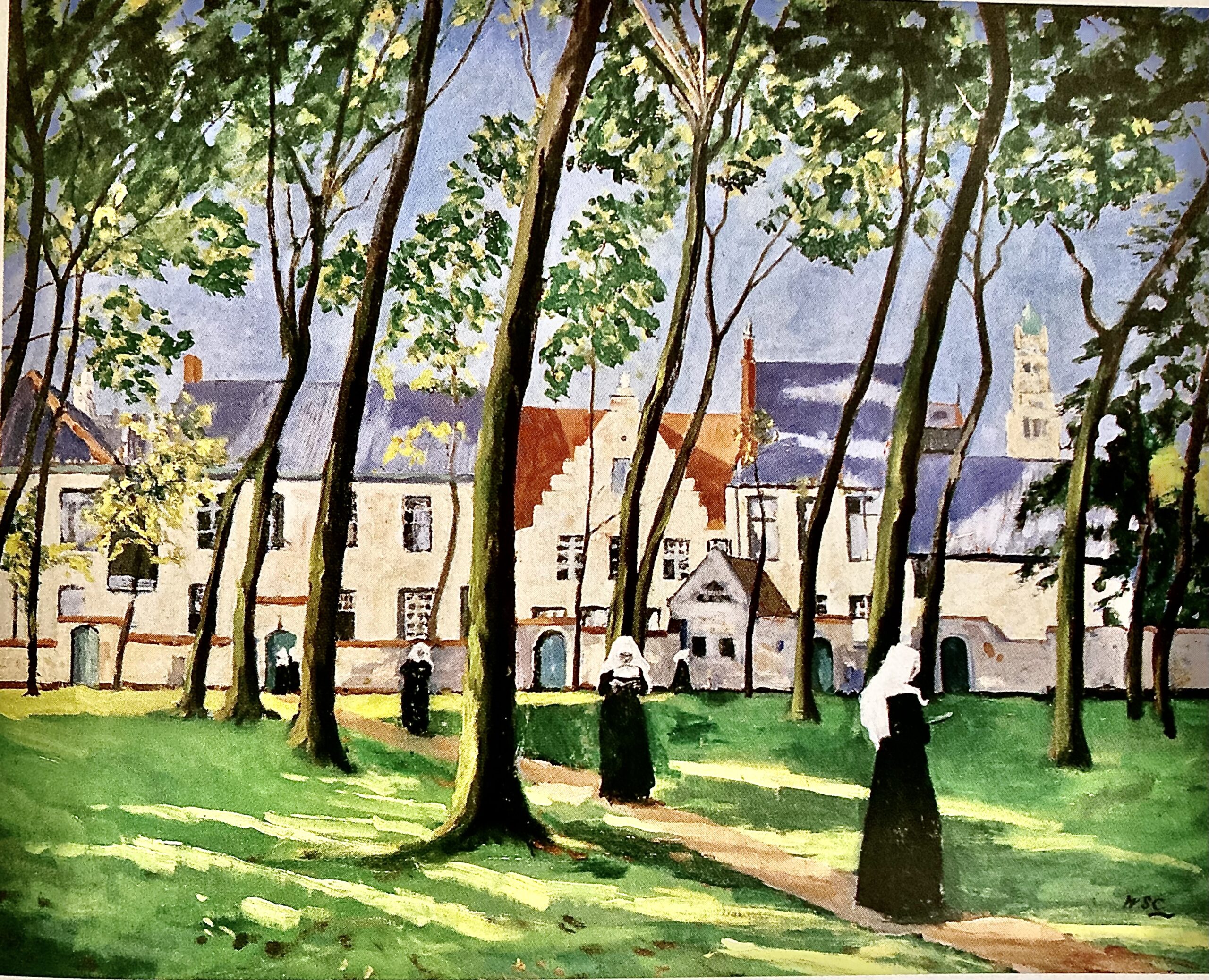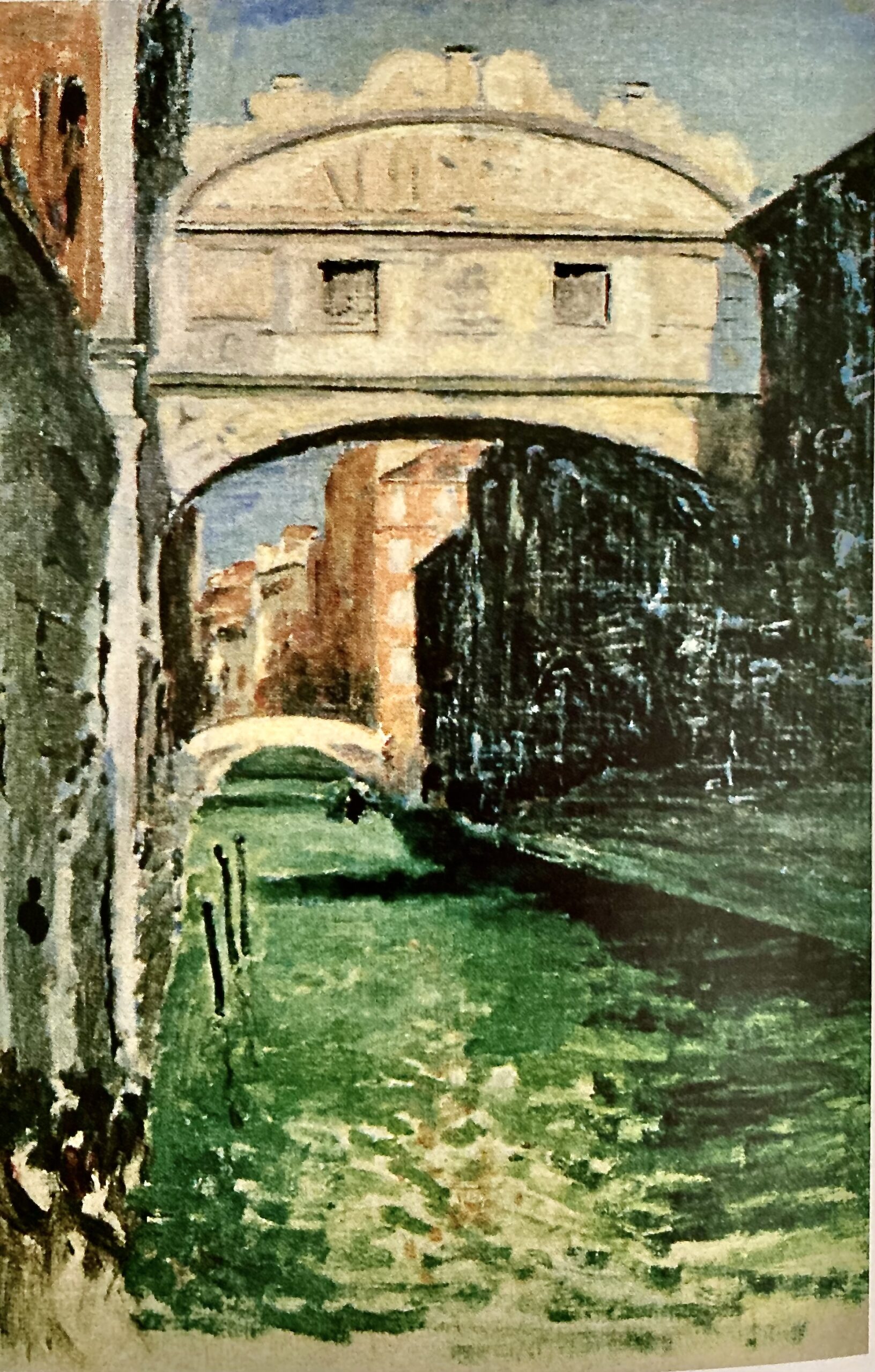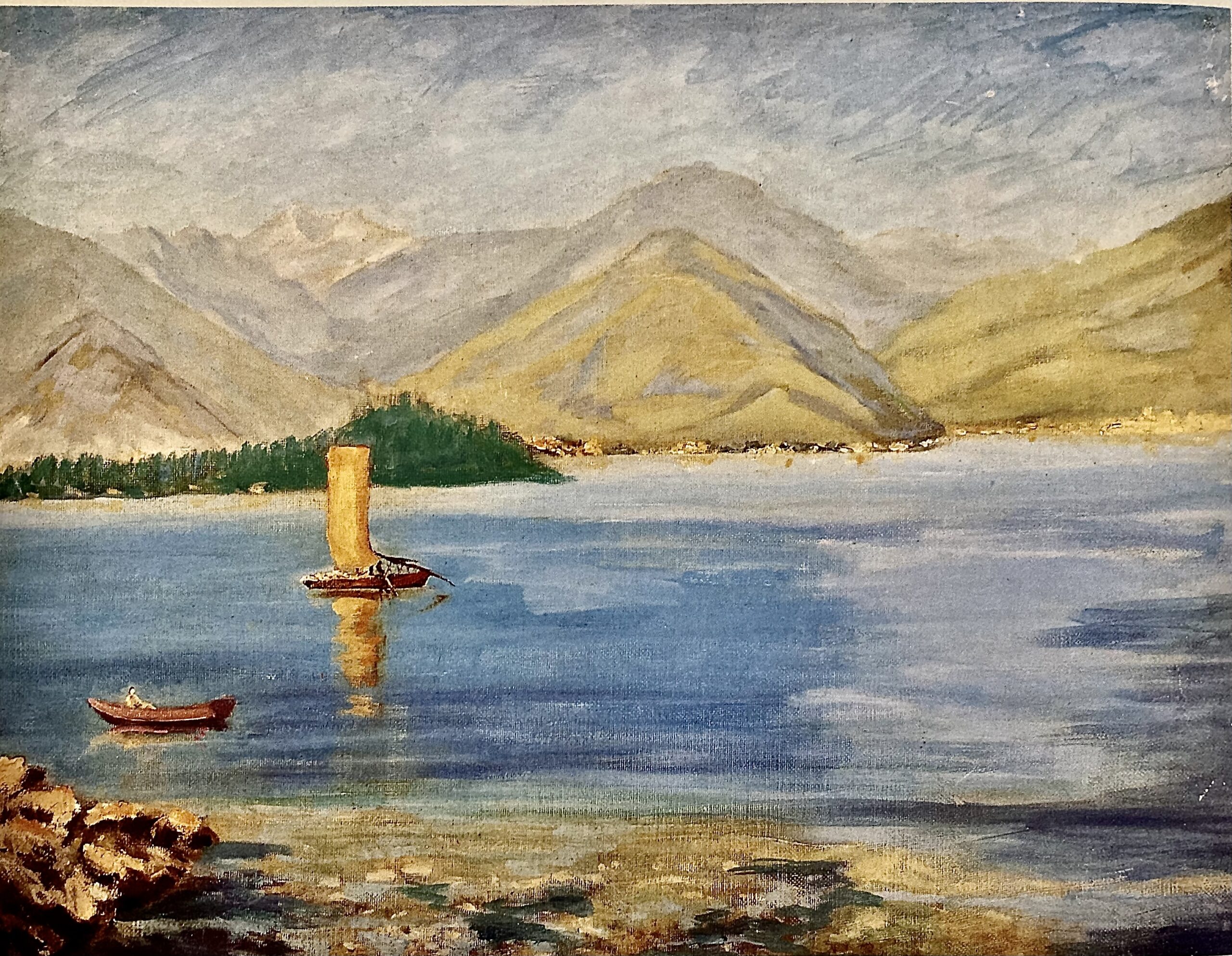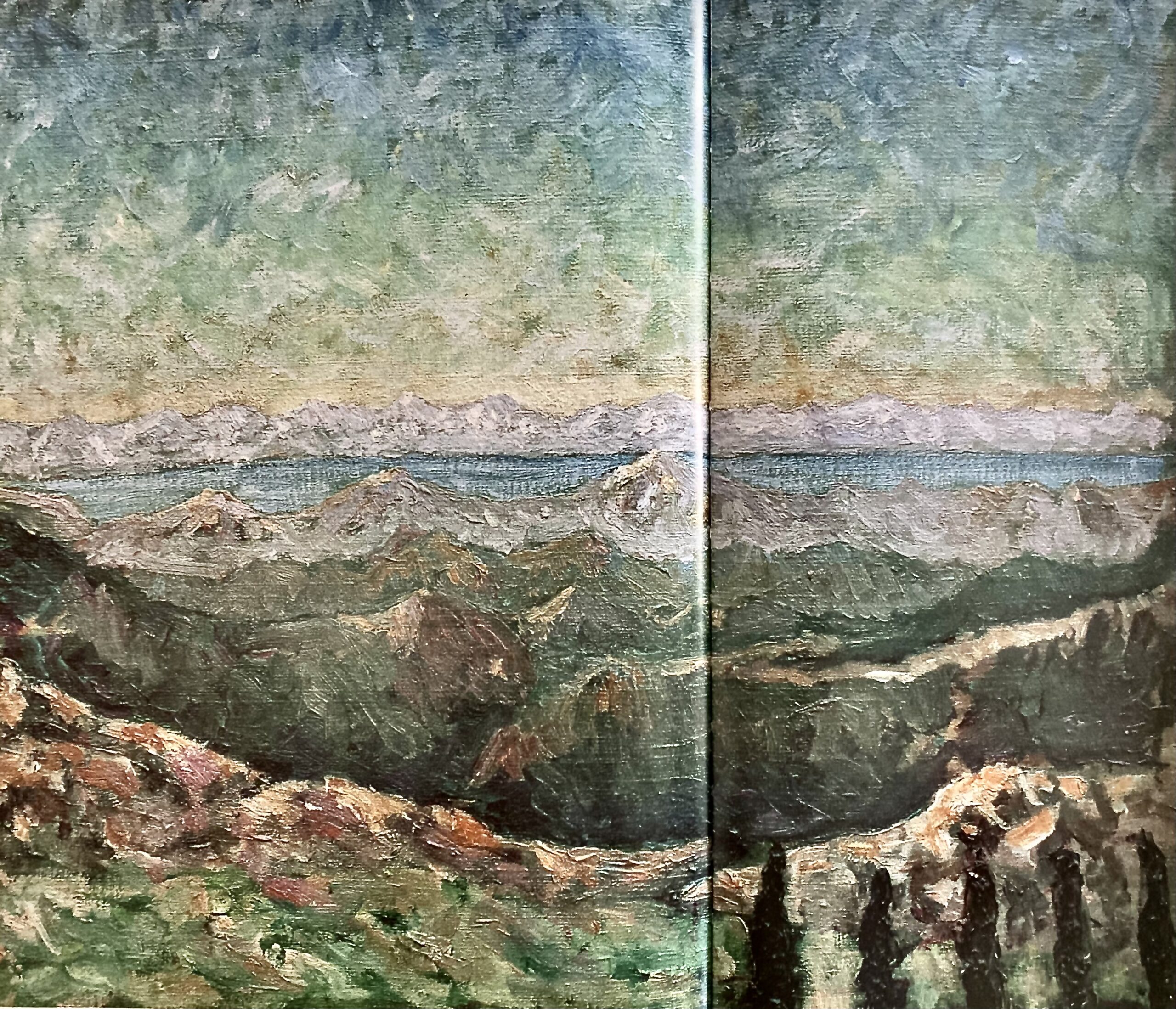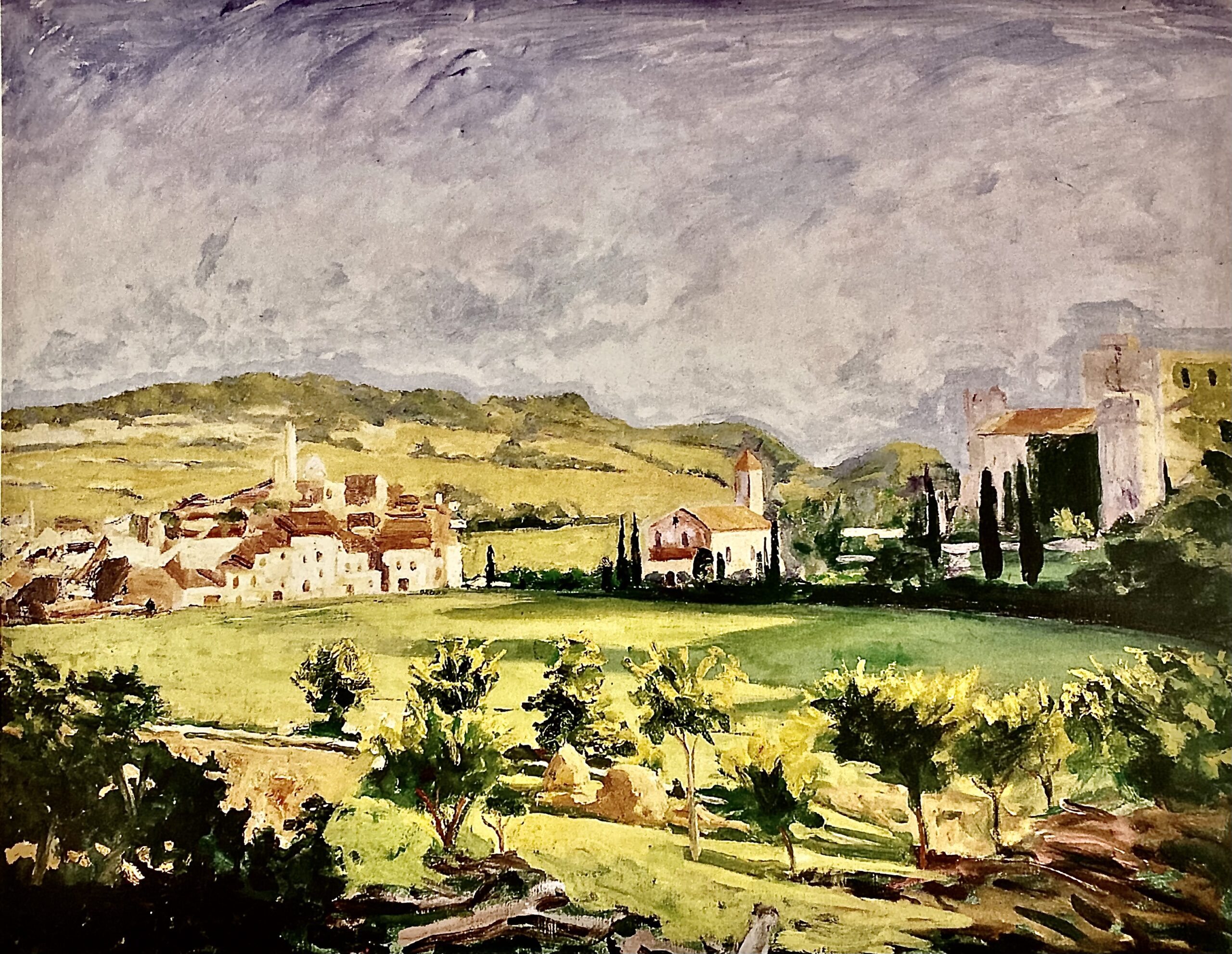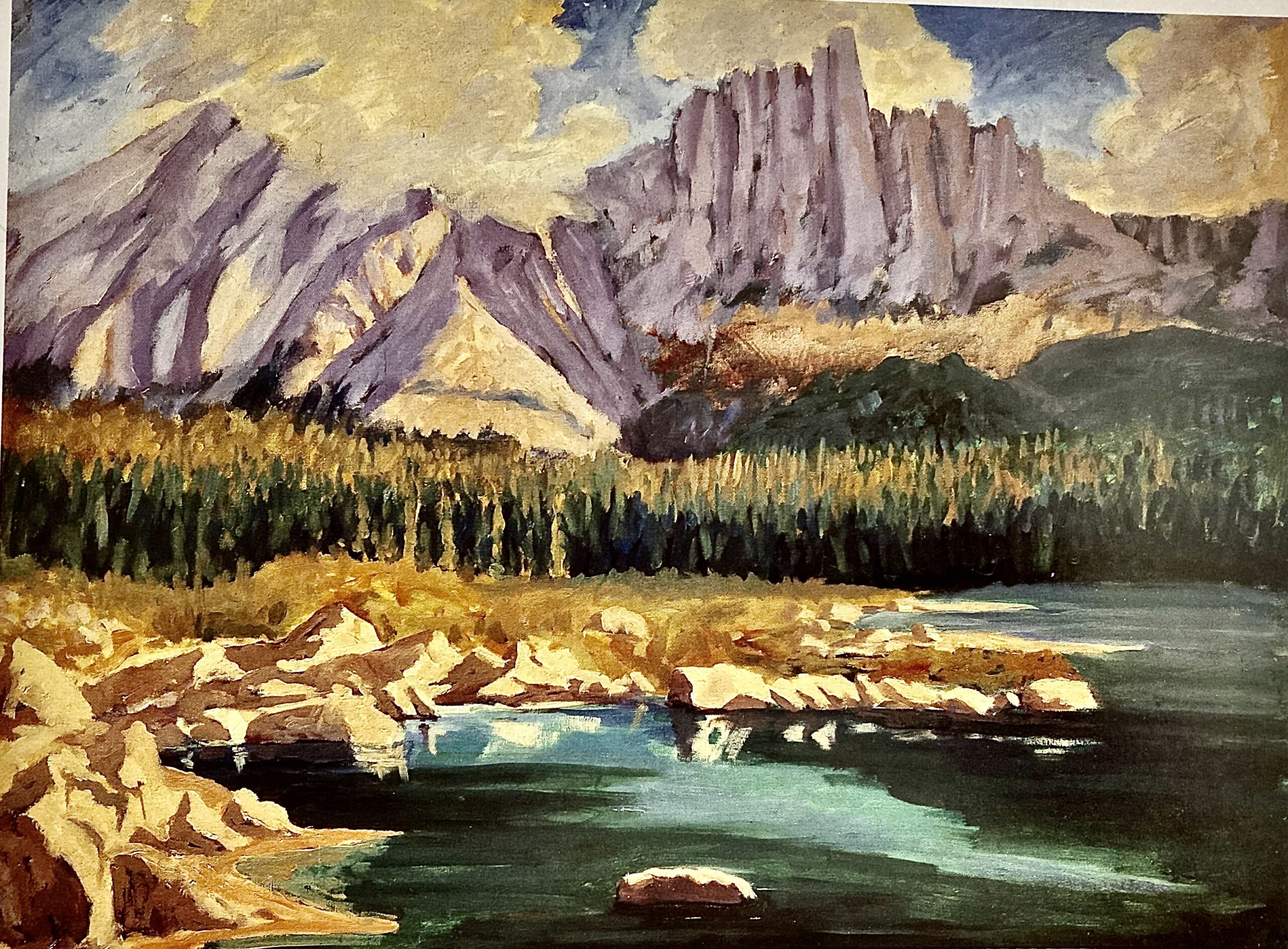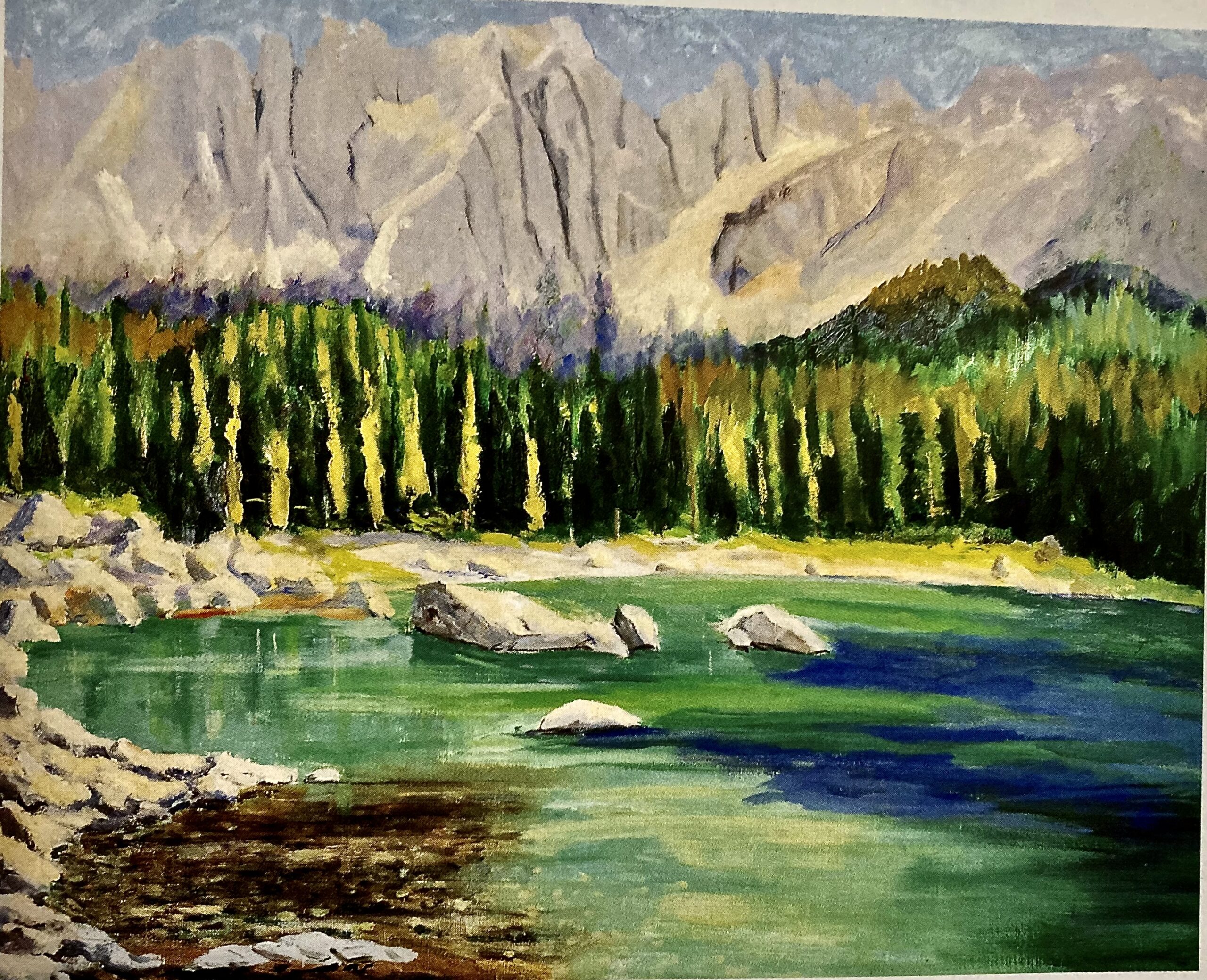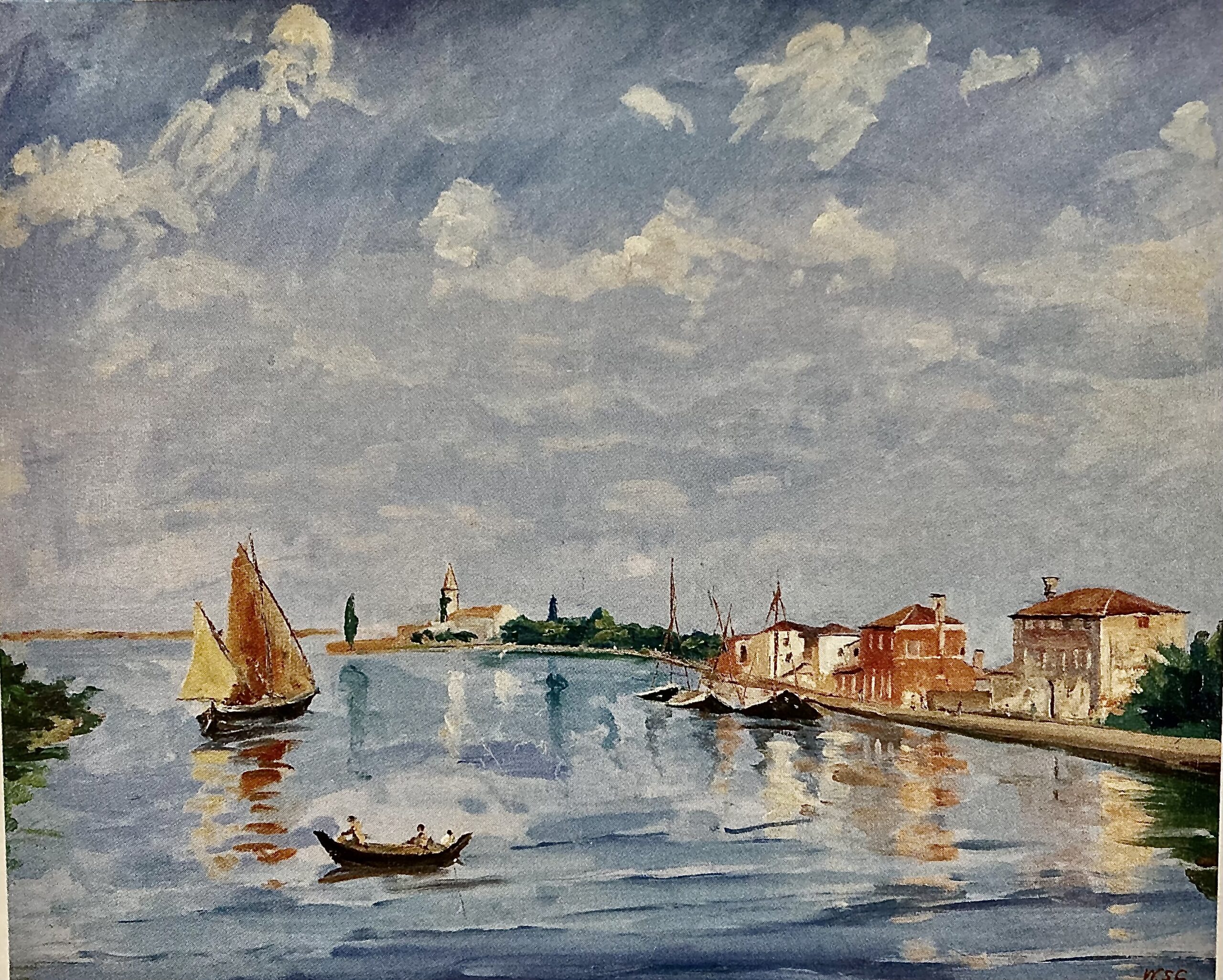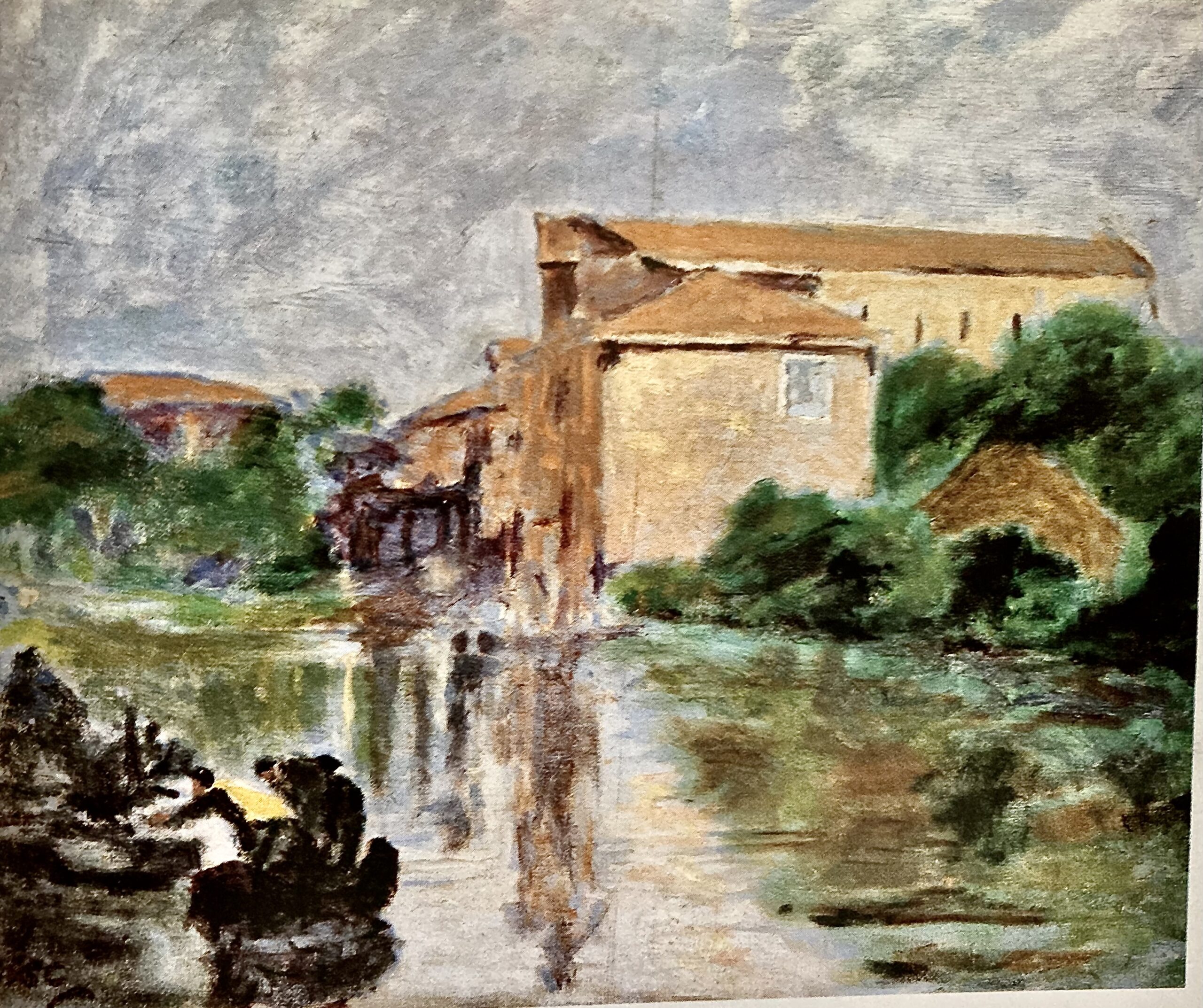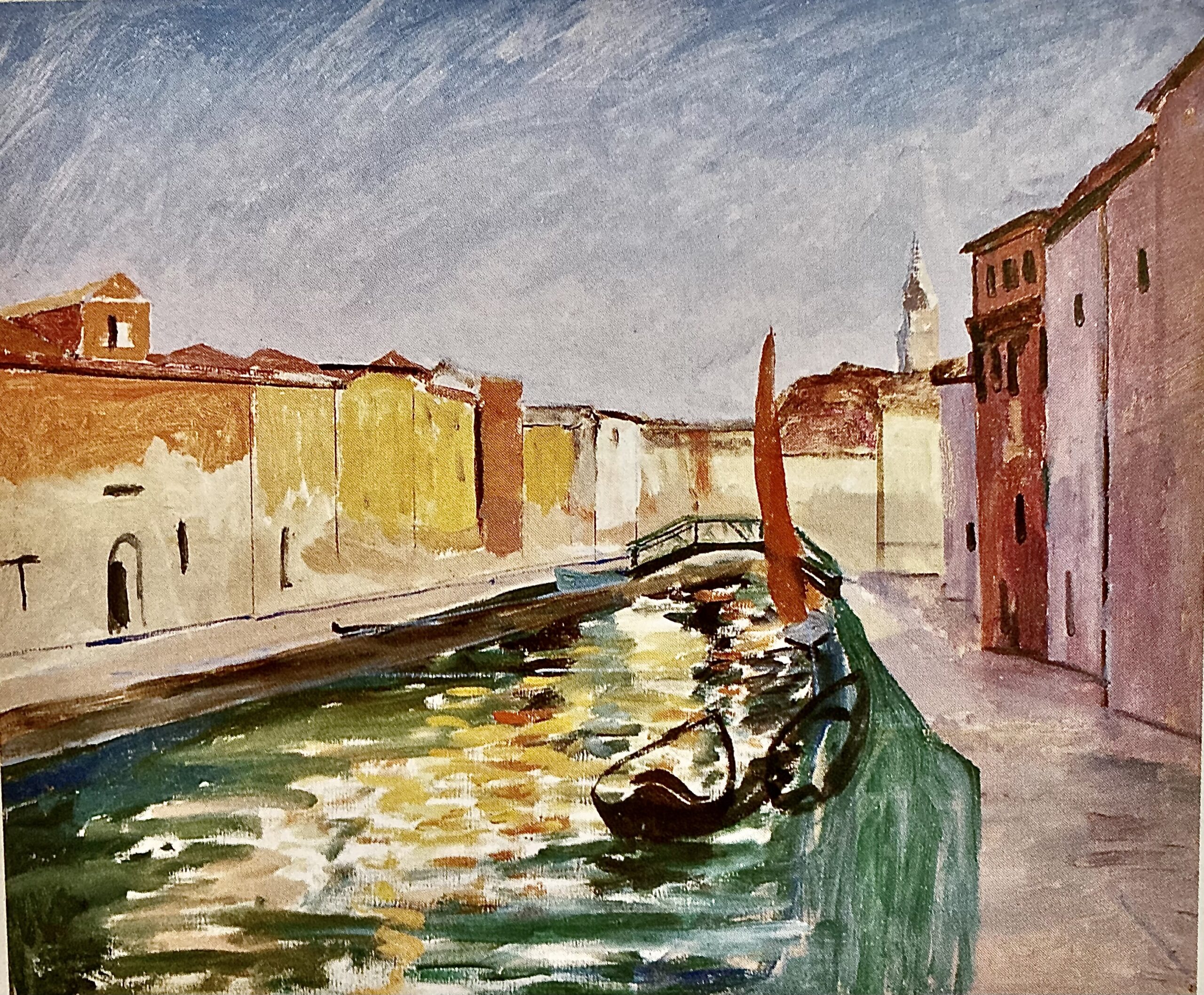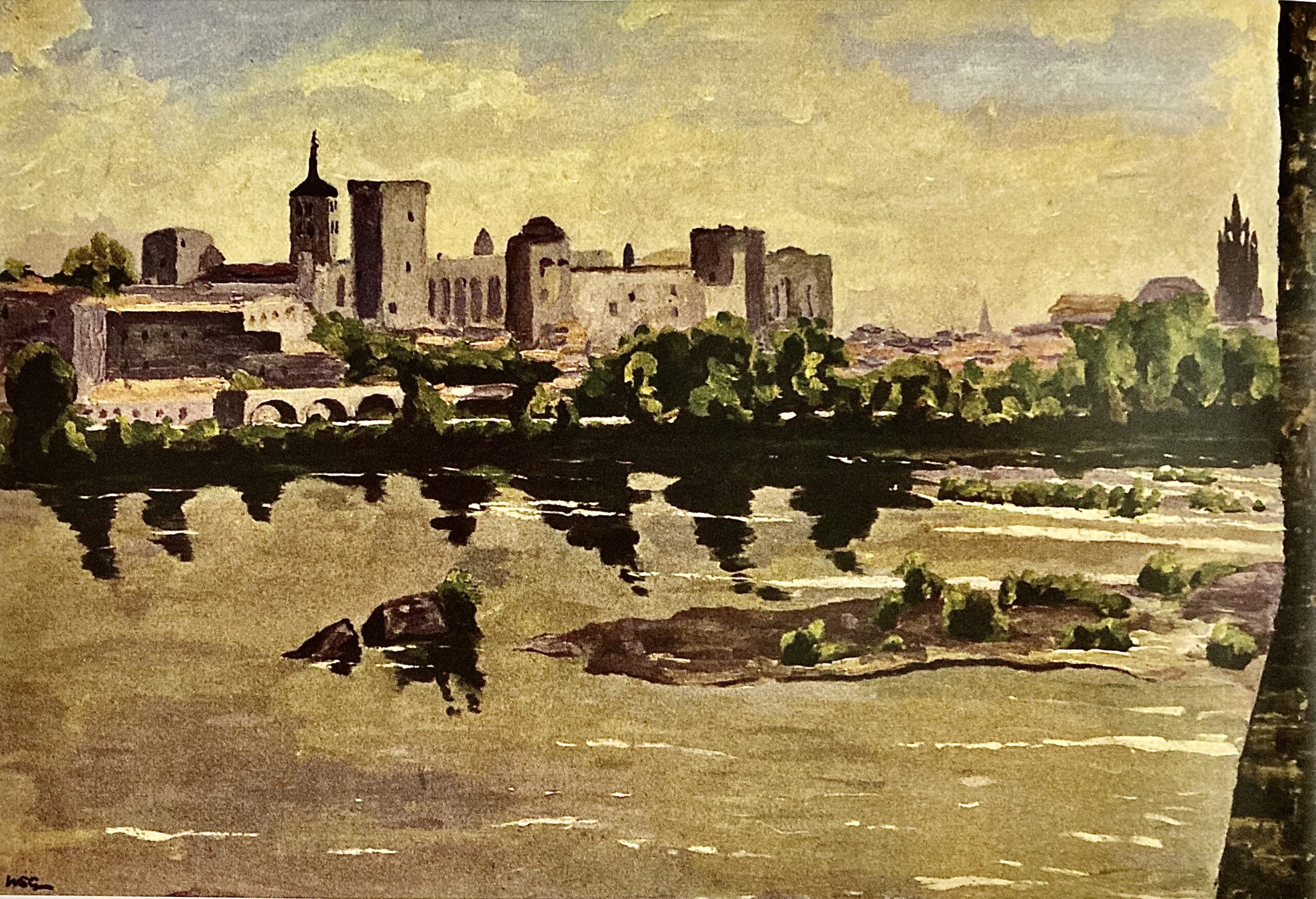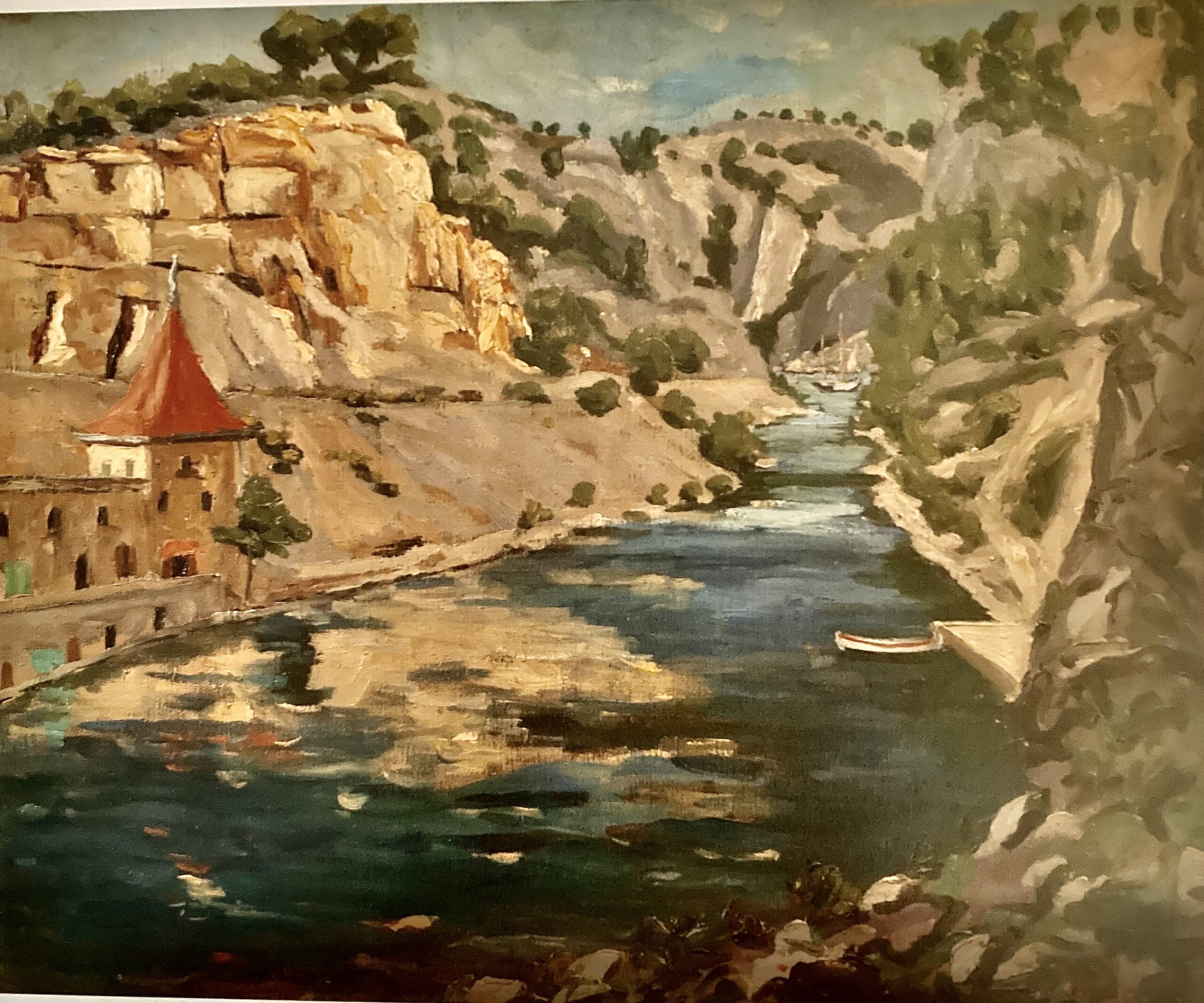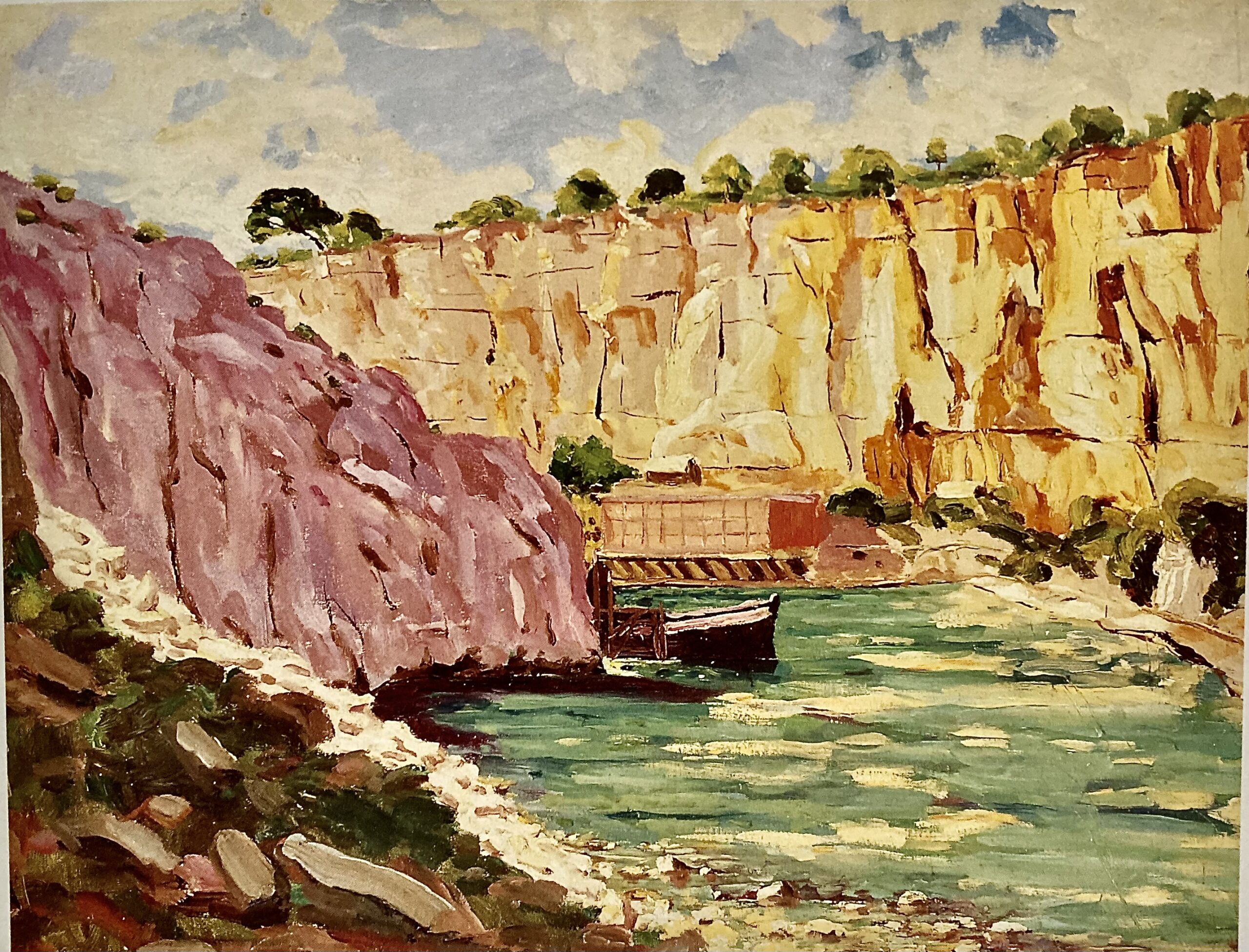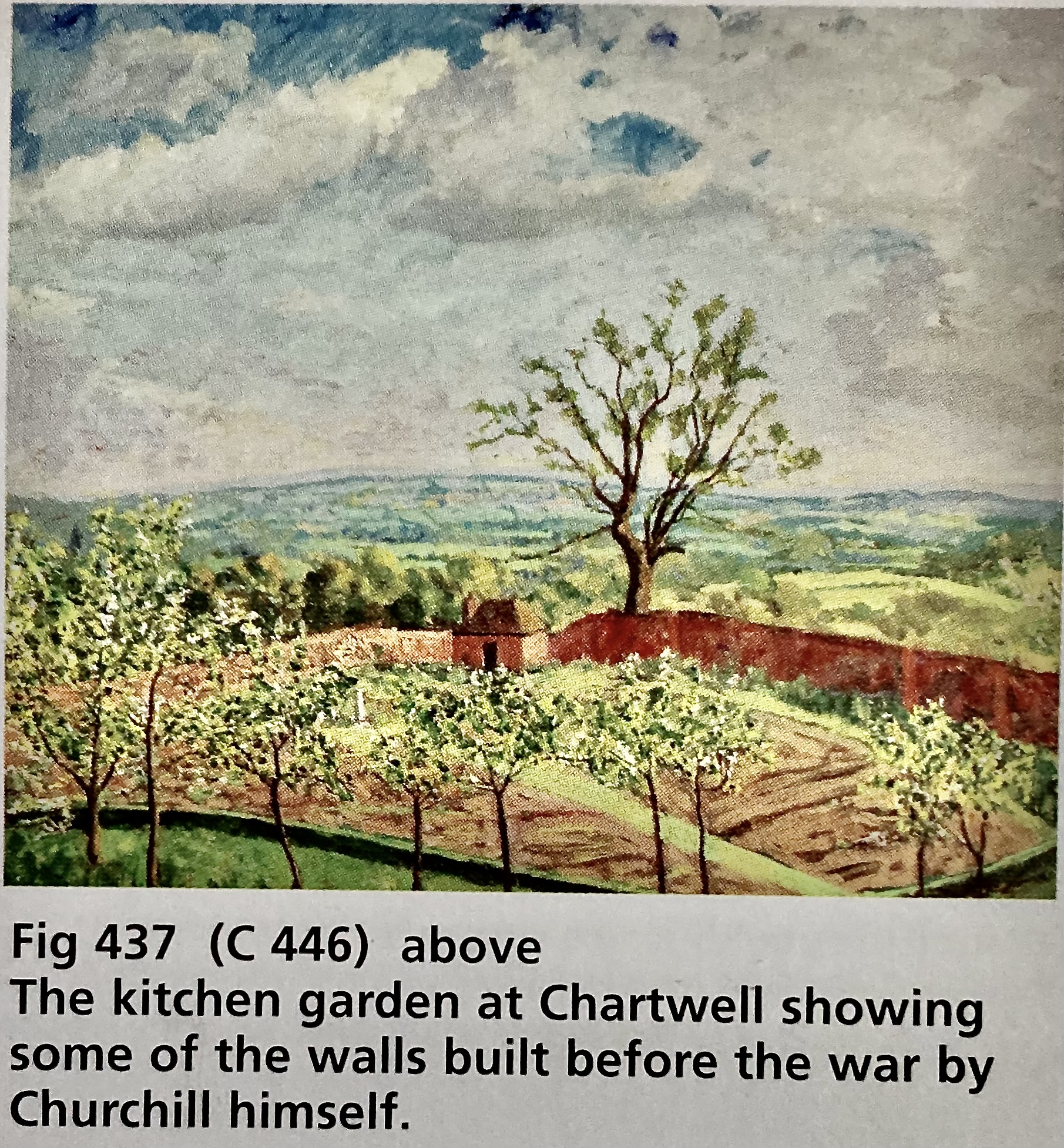
By Cheryl Anderson
“ I end where I began; I hope sincerely that these notes and sketches may encourage others to find out whether they have not got within them that love of colour and faculty of observation which will enable them to enrich their leisure with the delightful amusement of painting. At any rate I shall dwell in the comfortable expectation of stirring some slumbering genius into action, or at least of investing a modest life with a new sense of fullness, security and independence.”
—Winston Churchill
My series on Sir Winston Churchill as a painter is coming to an end. But, before I go I want to share a few Churchill anecdotes, his paintings I like, but previously had no where to incorporate them, his paintings of Bruges, Italy, en Provence, a wee bit of the English countryside, and a brief discussion about what is thought to be his last painting in 1962.

Original photograph, in the Studio archives at Chartwell.
A Grace Hamblin memory:
You may remember I wrote about nasturtiums arranged by Churchill’s secretary, Grace Hamblin, at Chartwell. Churchill was so taken with their colorful beauty he painted a picture of them. Grace worked for Winston and Clementine from 1932. After the war, she recalled that paintings were stored in a drawing room that was not in use at Chartwell and relating that in the morning he would announce to his secretary, “I’ll hang pictures today…He liked a secretary or someone with him to help line them up.” This also meant that a carpenter would be needed to follow them around as they decided where the paintings would best be placed. Churchill enjoyed days devoted to hanging pictures.
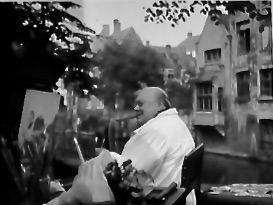
In the late 1950s he loved to stay at the home of Baron Vandereist. Photo taken at the museum, the home of Vandereist.
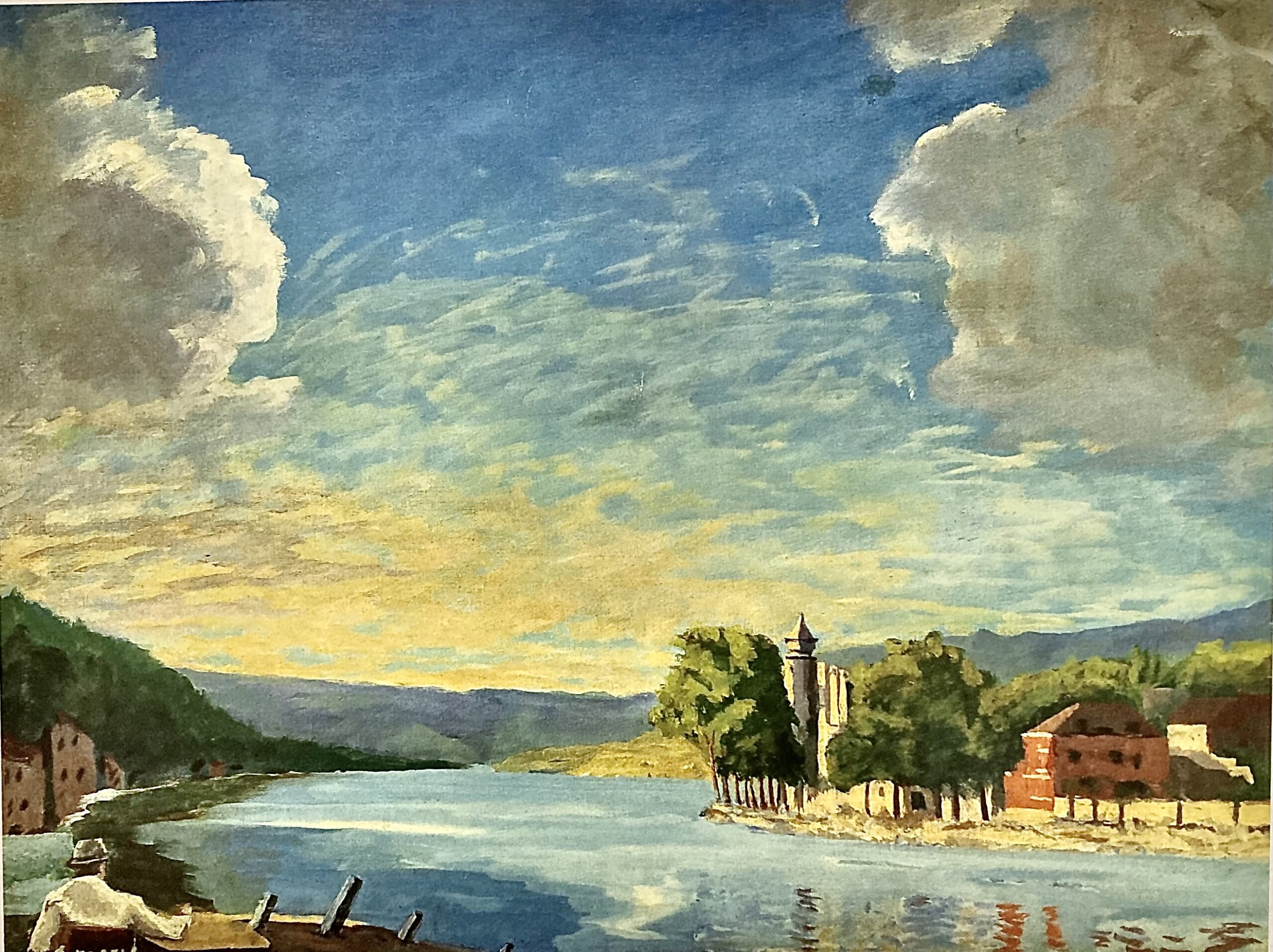
A scene on the River Meuse at Dinant in late 1946. The artist is seen in the left hand corner. Churchill had been invited by the Prince Regent to visit Belgium. The result of the visit were the views of the River Meuse.
“One day at Chartwell, Churchill brought one of his paintings in to the office. ‘He put it up and then he said, “What do you think of it?” It was one of his most terrible paintings. And he must have seen my expression, because I wouldn’t dare to criticize it. I know nothing about painting. I said, “Well, it’s not my favorite.” And he said, “Which is your favorite?” And I said, “Well, I love the Béguinage.” So he said, “Oh, well, we’ll put that here.” Some years later it went on exhibition with others to New York. When it came back and I was helping him unpack it, he said, “This is yours. Take it home.” That’s all there was to it. Just like that…enough to kill anybody.I couldn’t believe it…to receive one of the paintings, and from him! ”
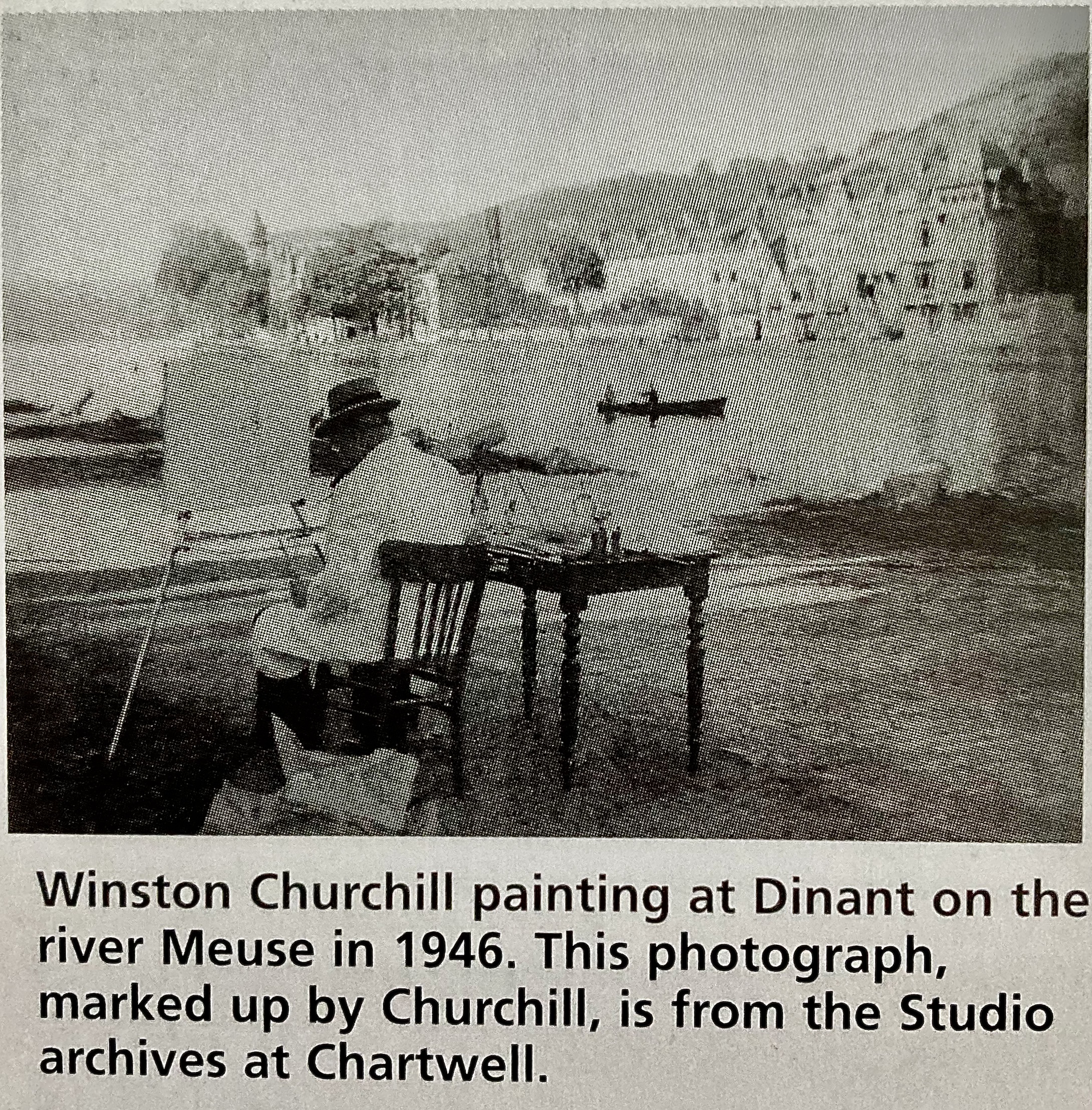
Scene of the Meuse with the artist himself in the left hand corner. The three paintings of the River Meuse are based on a series of photographs from the Studio archives at Chartwell. |
Scene of the Meuse with the artist himself in the left hand corner. The three paintings of the River Meuse are based on a series of photographs from the Studio archives at Chartwell. |
“ ‘Sir Winston didn’t care to give his pictures away, but after the war he gave away quite a lot…as acknowledgement of something that had been done for him. they were mostly particular friends.’ His frame maker Frank Patrickson would pack them up and send them away. ‘Sir Winston and he would sit down and initial a batch. He wouldn’t do it on the way.’ ”
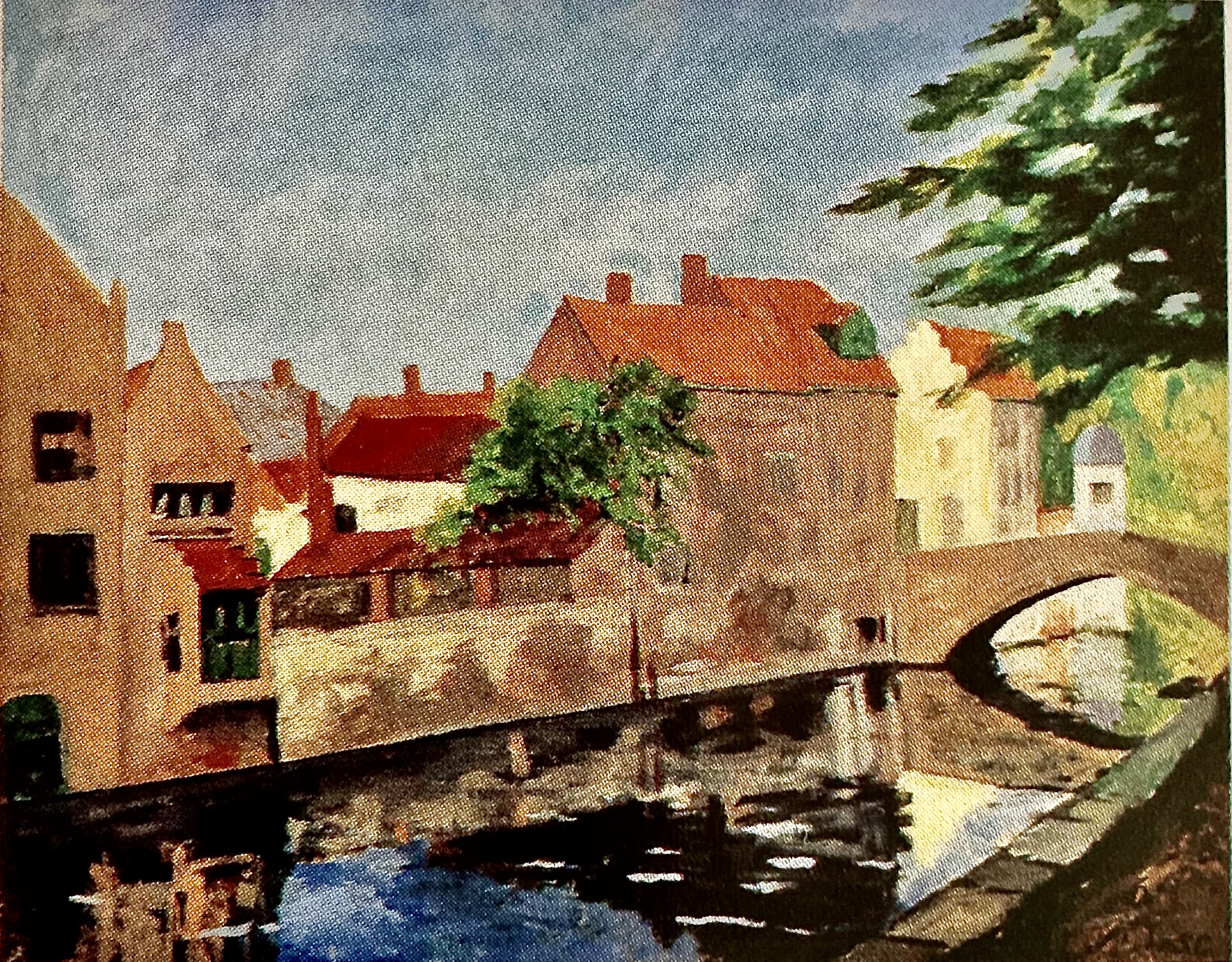
Canal scene at Bruges from small photos in the Studio archives at Chartwell.
“ ‘I adored Lady Churchill, but not for a long time…she needed a lot of knowing…she knew exactly what she wanted. Inside herself she was an extremely good woman. She took a great interest in [Sir Winston’s] painting…and she could criticize, she was very, very good. He took notice, he might not appear to, but he did. They loved each other dearly. It was extraordinary and it remained.’ ”
The painting Grace was given was, Le Béguinage in Bruges, 1946. “A 16th century convent, the Begijnhof (in Flemish) is occupied by the Benedictine nuns. Churchill based this painting on a series of small photographs of the nuns walking round their shady oasis; he had enlargements made of some of the figures so that he could place them exactly where he wanted in the painting. The original photographs are in the Studio archives at Chartwell.”
|
Le Béguinage in Bruges, 1946 |
Winston Churchill painting at Béguinage, Bruges, 1946. The photo corresponds to the painting with nuns. |
Late in 1946, by invitation from its Prince Regent, Churchill made a visit to Belgium. Pictures with this article are a few of the paintings of the River Meuse that resulted from the trip.
Scene on the River Meuse.
Sergeant Walter Thompson, Churchill’s personal armed police bodyguard, remembers:
“ ‘I have been with [Churchill] on various painting holidays and the intensity with which he has thrown himself into the task has amazed me. He would start painting in the early morning and continue with work until 7 o’clock in the evening with only a short break for lunch…He would frequently call upon my services to supply him with a dab of this or that. At the end of a long day, I would take it upon myself to clean his palette, which always looked like fifty rainbows.
|
The ladies in a Gondola in Venice are thought to be Clementine and Diana Churchill on holiday in 1927 and may have been painted from a photograph. |
Bridge of Sighs, Venice. |
‘When I finished my first tour of duty in 1931, I plucked up my courage and asked… “Would you be willing to give me a painting, Sir?” I have only known him to give away his work on two occasions…He replied, ‘You pick whatever you like, Thompson, and you can have it’…Eventually I decided upon a picture that I had seen him paint while he was staying with Sir Philip Sassoon at his house in Barnet…I asked him if he would sign the picture for me. He answered… “I have never signed one, Thompson, but I will initial this for you.”
|
View of Lake Maggiore. Clementine and Winston spent part of their honeymoon there in 1908. |
View of the Italian Alps. |
Mrs. Julia Tickner was a former housekeeper at Hoe Farm and widow of the head gardener. She wrote to Churchill in 1963,
“…that she was carefully looking after two of Churchill’s paintings, which had been left with her to dry when the family stayed at the farm in 1915. “How very kind of you to have looked after my paintings so faithfully for all these years and to have kept them in such excellent condition.” A copy of, Painting as a Pastime, was sent to Julia along with the thank you note.

Scene on Lake Como. Dating from 1945 or 1946 when he was experimenting woring on larger canvases.
In 1945, Churchill’s family decided he needed a painting holiday after being turned out of office. Field Marshal Alexander, the Supreme Allied Commander of the Mediterranean, offered Winston the use of Villa delle Rose, the former wartime headquarters on the shores of Lake Como.
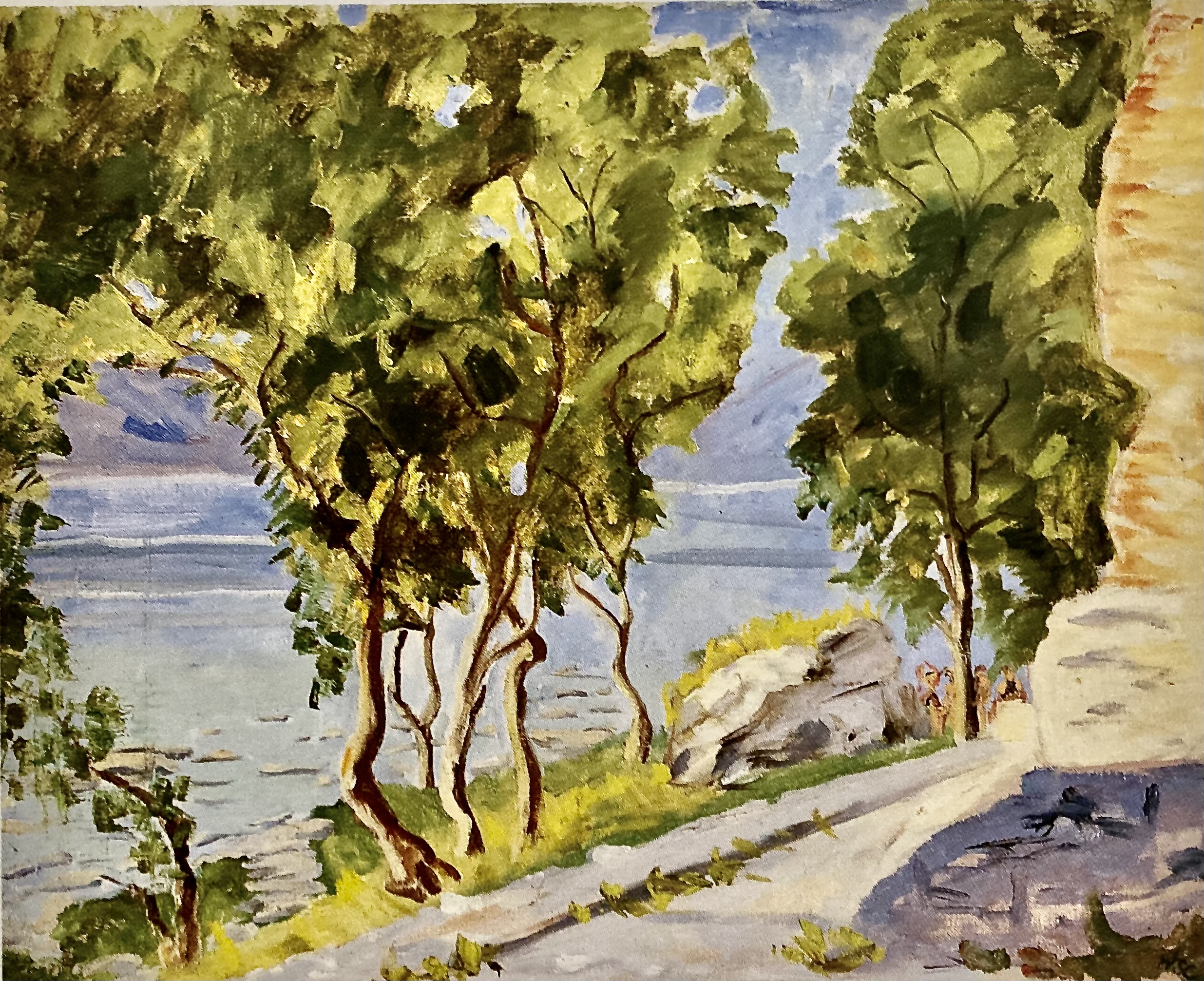
This scene on Lake Como is said to have been painted in one hour. It may date from 1948.

Viullage scene on Lake Lugano, 1945.
Alexander wrote, “I purposely avoided interfering with his holiday though I did stay with him for just one week-end, when we spent the Sunday painting. At one point [Churchill] turned to me and said. ‘You know, when I was turned out of office, I felt it to be a very hard thing after all I had done.’ Then with a smile, and waving his hand to the scene he was painting, he added, ‘But life has its compensations, you know-if I was still in office I wouldn’t be here to enjoy this lovely climate and marvelous landscape.’ ”
On this holiday, he also painted scenes of Lake Lugano. He was joined by Charles Montag, who came down from Paris and Sarah Churchill, later recalling, “The days are filled with painting and picnics.”
 |
 |
Churchill visited La Provence a number of times in 1948. He chose to paint La Montagne Sainte-Victoire with the house of the French artist, André Masson, a Cubist and Surrealist, in the foreground. The house is still standing. During the First World War Mason fought for the French and sustained serious injuries. The Nazis condemned his work and was forced to escape from Marseilles to the French island of Martinique and then traveling on to New York. His work influenced Jackson Pollock. Cézanne, whose work Churchill was familiar, painted the mountain one hundred times.

An early sketch of a town on the French Riviera.
 |
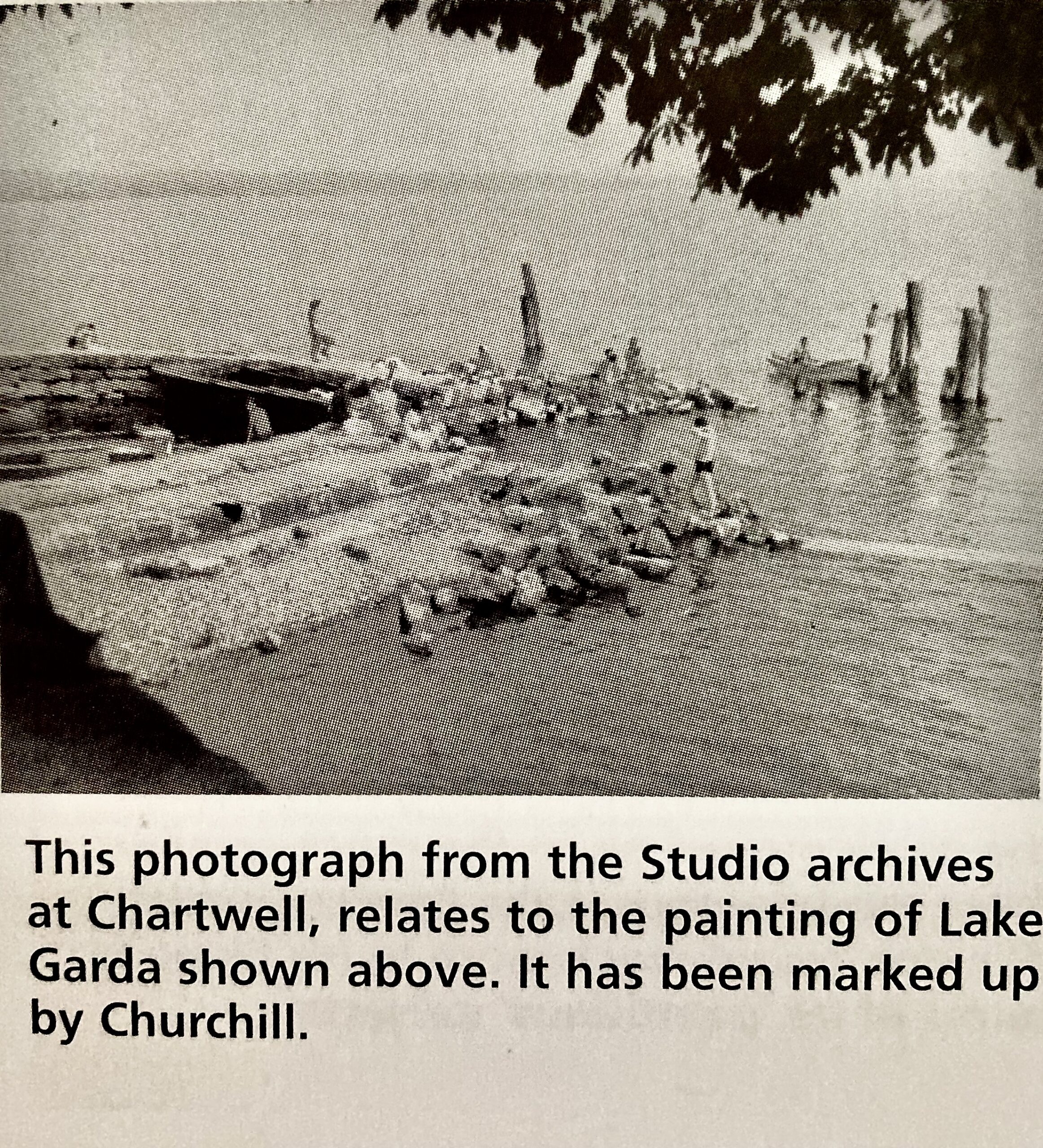 |
Les Trois Sautets (three small jumps) bridge over the River Arc was built in approximately 1655 is near Aix-en-Provence. It is still in use. One of his paintings of the bridge was given to his paint manufacturer, Willi Sax. Lourmarin was another destination for Churchill en Provence. The farm garage is still there from where Churchill painted, Château de Lourmarin. I plan to visit Lourmarin this September, take lots of pictures and stories that I will share in the coming months.
|
Château de Lourmarin painting, 1948. |
This day, Churchill chose the afternoon light to paint Château de Lourmarin. |
|
Farm house in Lourmarin Churchill painted from as it is today. |

xxxxxxx |
Before Churchill attended the first meeting of the Council of Europe in Strasbourg in 1949, he and Clementine went on a trip to Lake Garda in the Dolomites but moved on to the smaller and more mountainous Lake Carezza. He found Lake Carezza “more to his liking”, and it had very “paintacious” scenery.
View of Lake Garda.
|
Lake Carezza in the Dolomites. |
Lake Carezza |

Lake Carezza painting was given to his solicitor, Anthony F. Moir.
Churchill’s winter holiday trip to the Atlantic island Madeira in 1950 was interrupted by the calling of a general election in Britain. He hurried back home leaving the warm weather he so enjoyed.

Churchill working on the Lourmarin painting surrounded by paint brushes, jam jars, paint tubes in their box, and an oblong pallette.
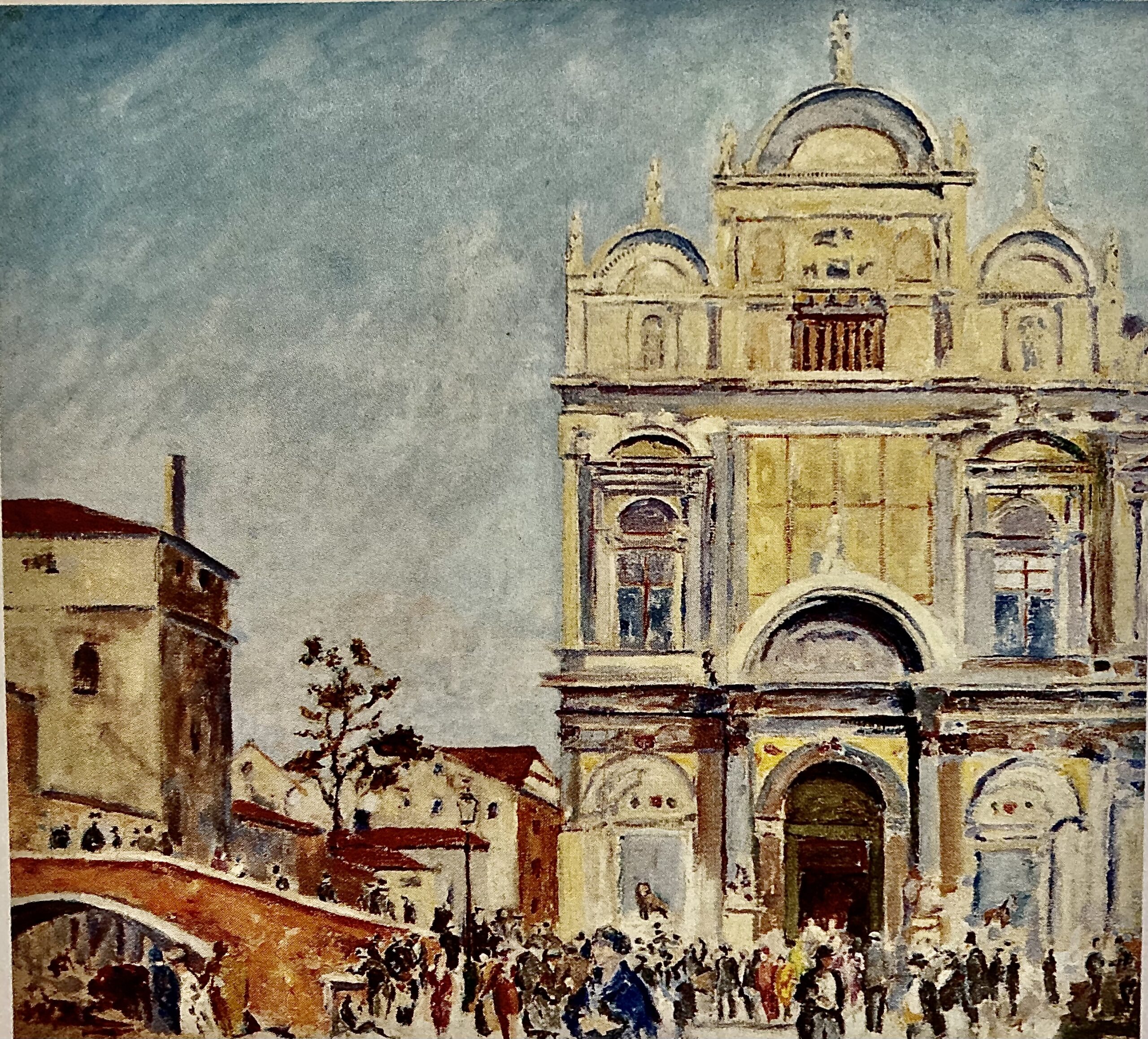
The Scuola di San Marco in Venice.
|
Near Venice, 1951. |
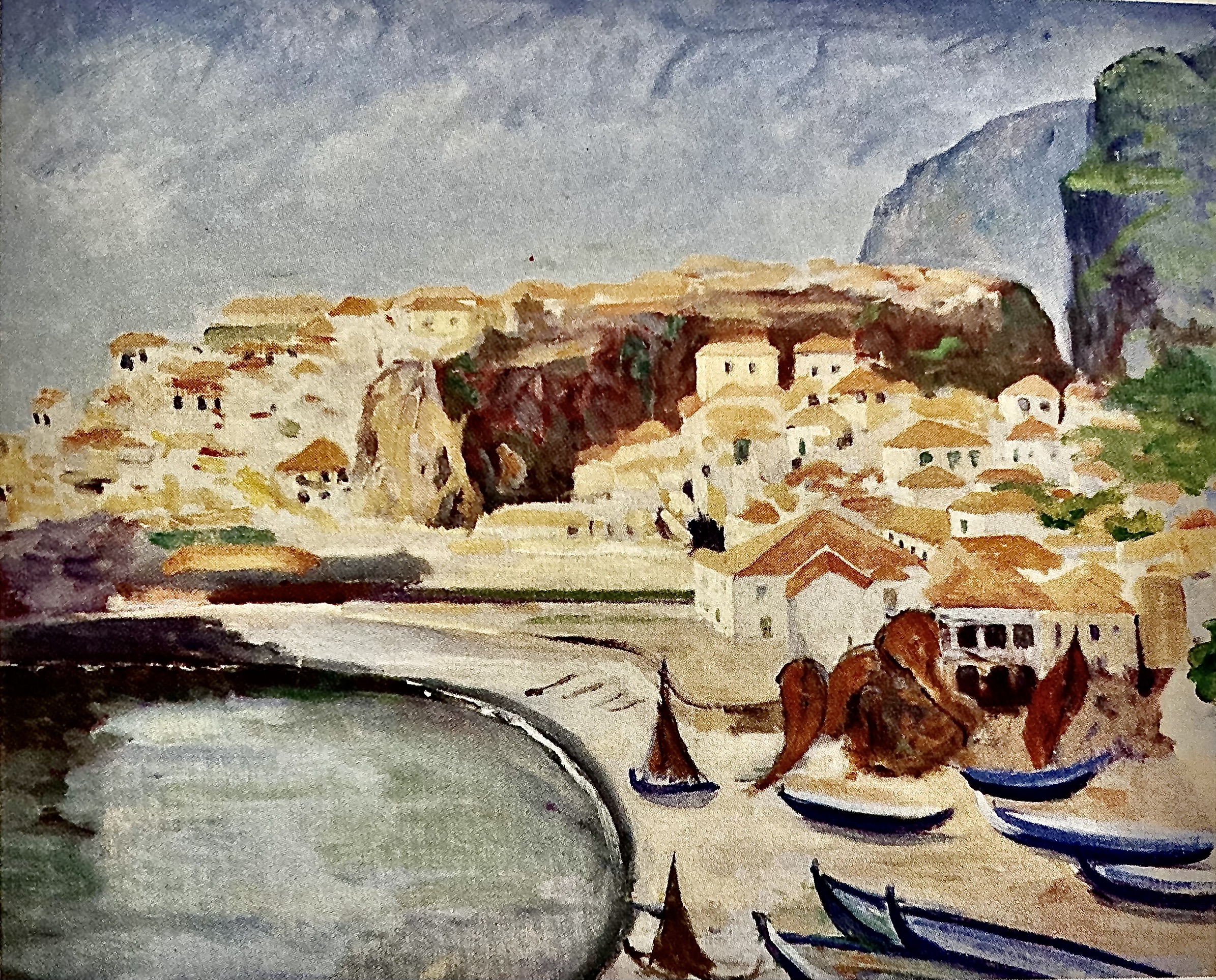
The Madeira painting, 1950. |
A family trip to Venice in 1951 gave Churchill time to paint, work on “the fifth and penultimate volume of his wartime memoirs”, enjoy the warm climate he loved, and found time to swim in the Lagoon. His paintings from this holiday are charming.
|
Near Venice |
Torcello |
|
Unfinished Canal scene. |
“This painting of the Grand Canal in Venice with the Rialto Bridge was presented to the Palace of Westminster, seat of Britain’s Parliament, by Clementine after Sir Winston’s death in 1965.” |
|
A villa on Cap Martin. |
A Cactus, Cassis, 1925 |
|
A scene on Cap Martin, done in the 1940s. |
View of Avignon, 1931. |
On February 8, 1952, Churchill, along with other dignitaries, was standing at the bottom of the stairs of the plane returning Elizabeth home from her sudden abbreviated trip to Kenya. She had left England a princess and returned a queen.
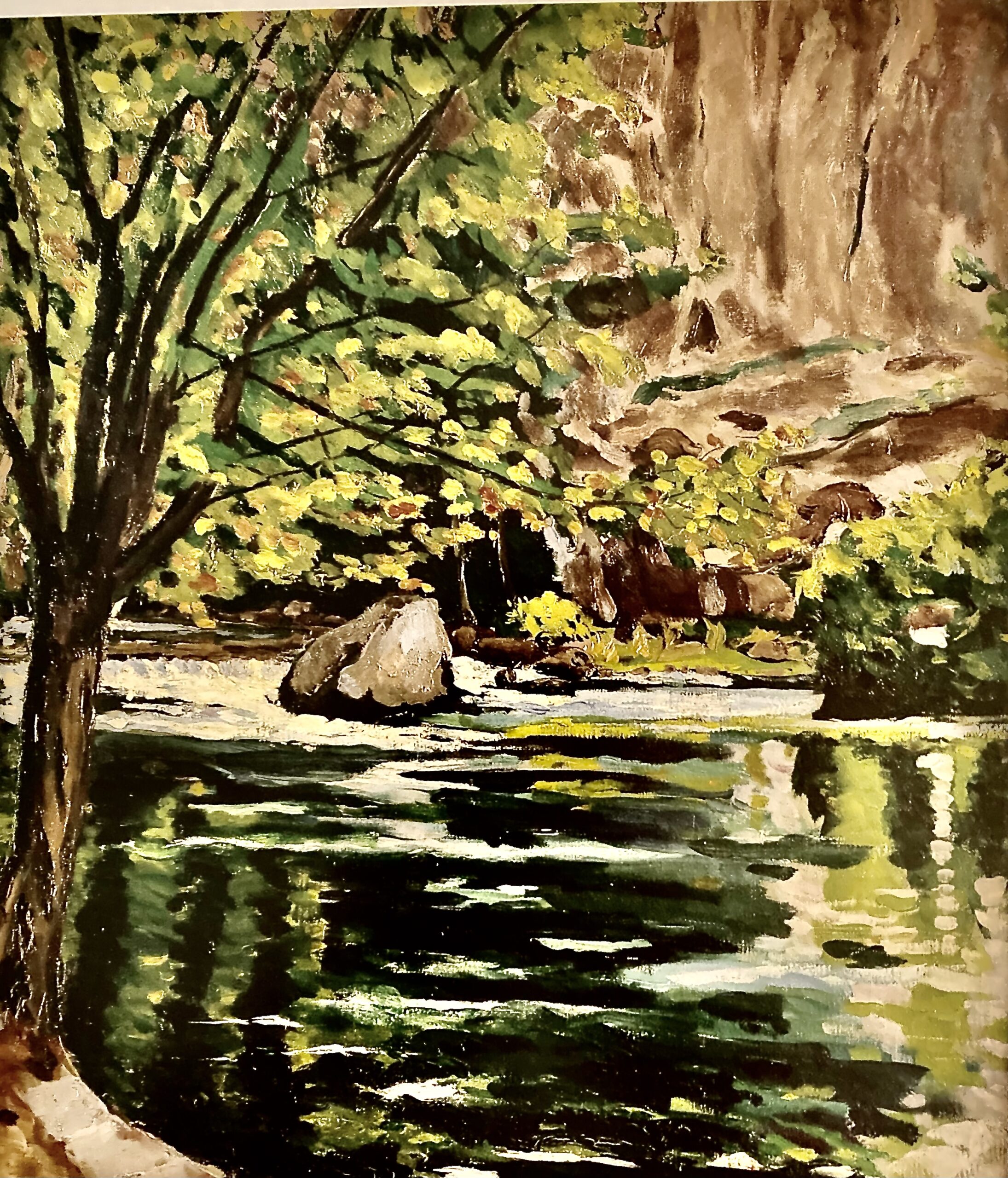
The River Sorgue near the Source, 1936.
|
The Calanques, Cassis Capitanerie Port Miou, 1920. |
“The Calanques, a series of rocky inlets on the coast near Marseilles.” |

Churchill painting on the River Sorgue. Lord Cherwell, to the right, is reading. The distinctive hillside was a clue leading Paul Rafferty to the exact spot. The house still stands. |
Churchill behind a wind-screen with his valet close by. |
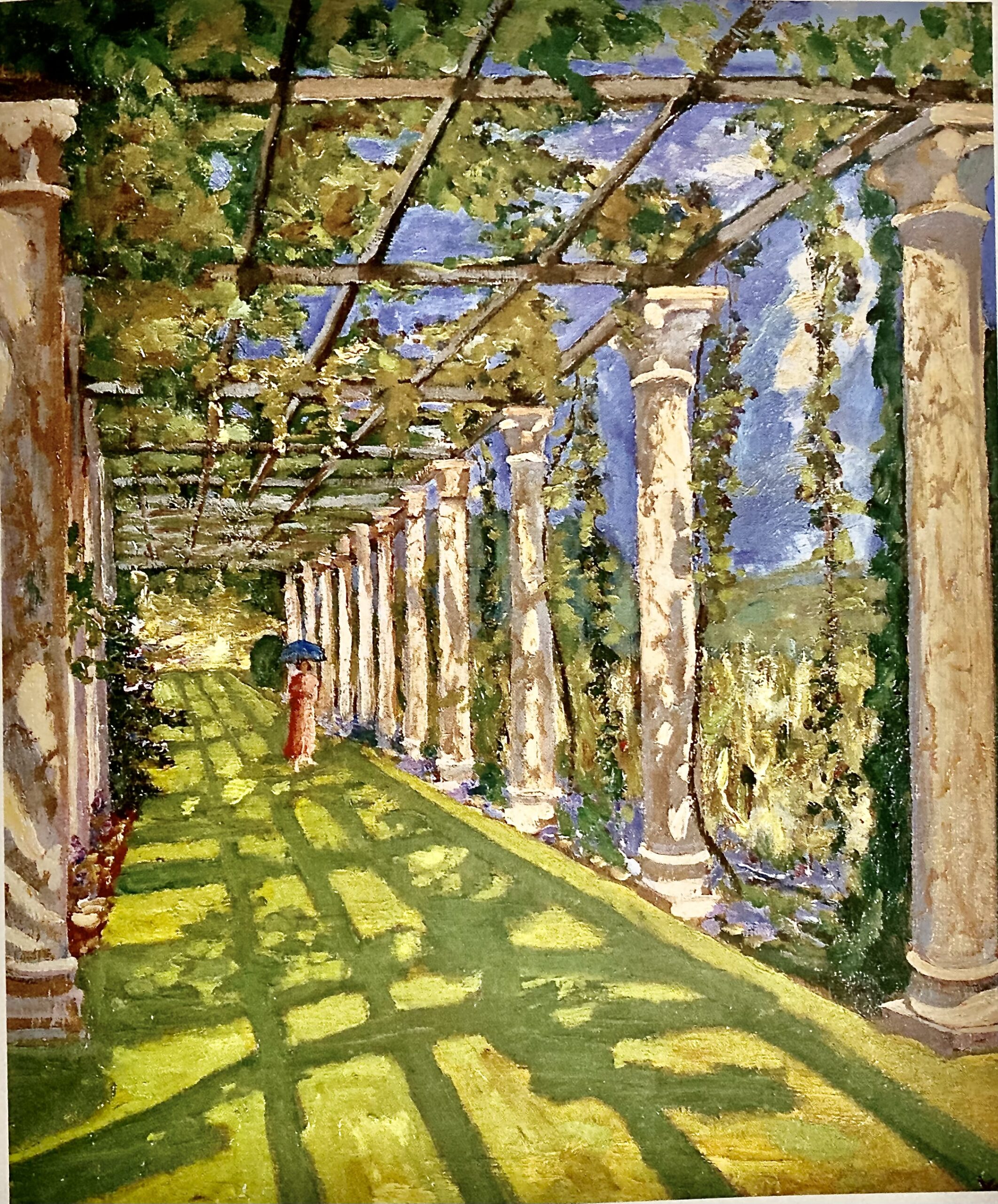 The Terrace at Trent Park. The Terrace at Trent Park. |
The Blue Room at Trent Park. |
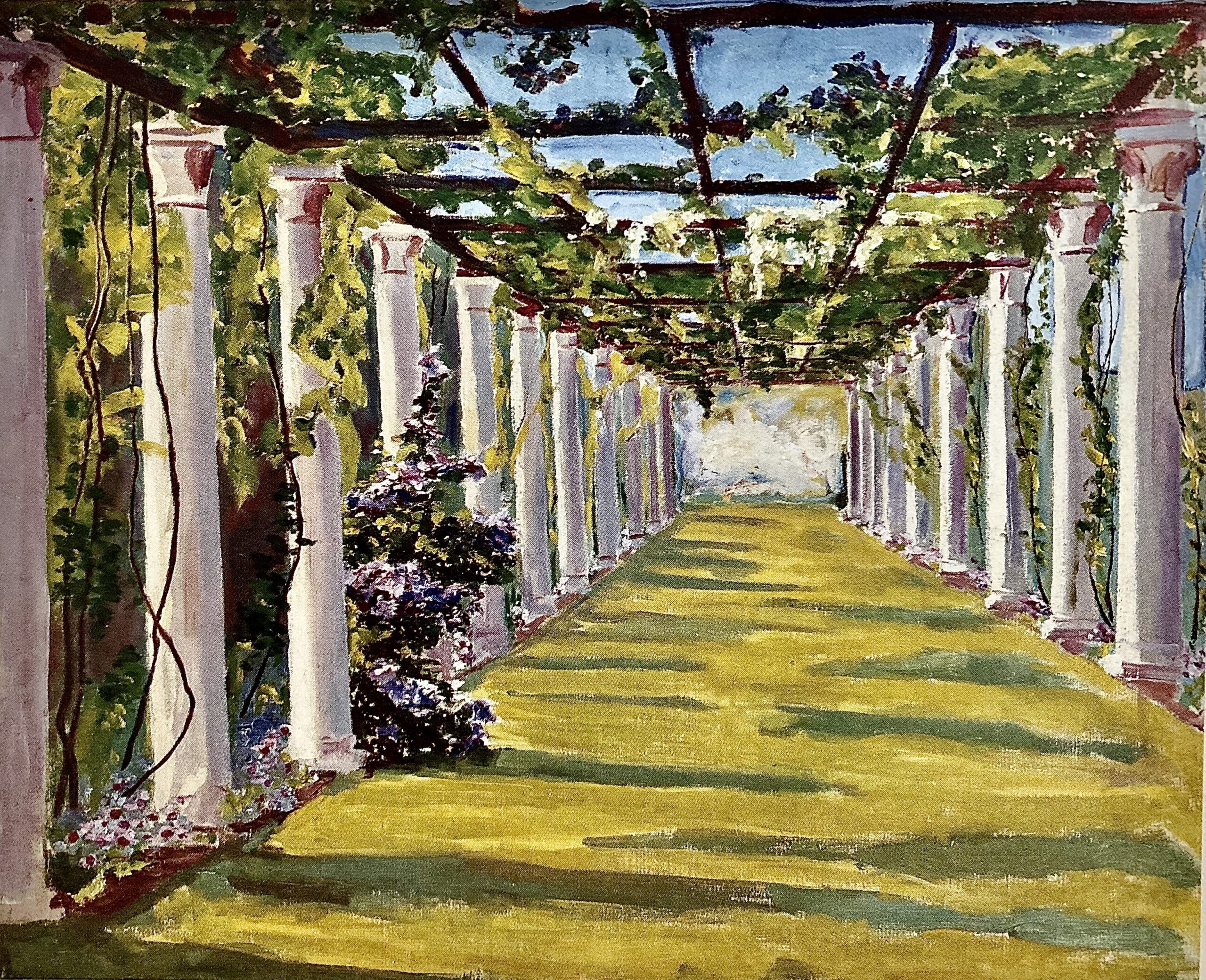
The Pergola at Trent Park. |

The Summer House at Trent Park. |
The story of what is thought to be Churchill’s last painting involves Sergeant Edmond Murray, Churchill’s bodyguard for the last fifteen years of Churchill’s life. Among his other duties, he was the custodian of Churchill’s painting equipment and whenever they traveled would set up the paraphernalia. One of Churchill’s most famous paintings is, The Goldfish Pool at Chartwell, done in the 1930s. His beloved Chartwell was among his most favorite places to be, and to paint.

“The Goldfish Pool. This is one of the series of Water Gardens near the house at Chartwell that Churchill created.”
|
View from the Stone Terrace at Lympne. |

Churchill is shown working on View from the Stone Terrace at Lympne. |

Landscape near Lympne.
In 1962, Churchill was eighty-seven years old. Murray encouraged Winston to paint one last work, the second goldfish painting. “Unlike many of Churchill’s landscapes at Chartwell, this painting is unusual in zooming right into the water, and taking in the luscious foliage along the waterside. It is an exemplary essay in tonality and near-abstraction, combining multiple hues of greens and browns to striking effect the Golden Orfe brought to life through vivid flashes of orange impasto.” That Winston should choose to go to the goldfish pool seemed only natural for one last painting. The pond was one of the water gardens Churchill created near the house at Chartwell where he enjoyed feeding the Golden Orfe, “whose descendants still swim there.”
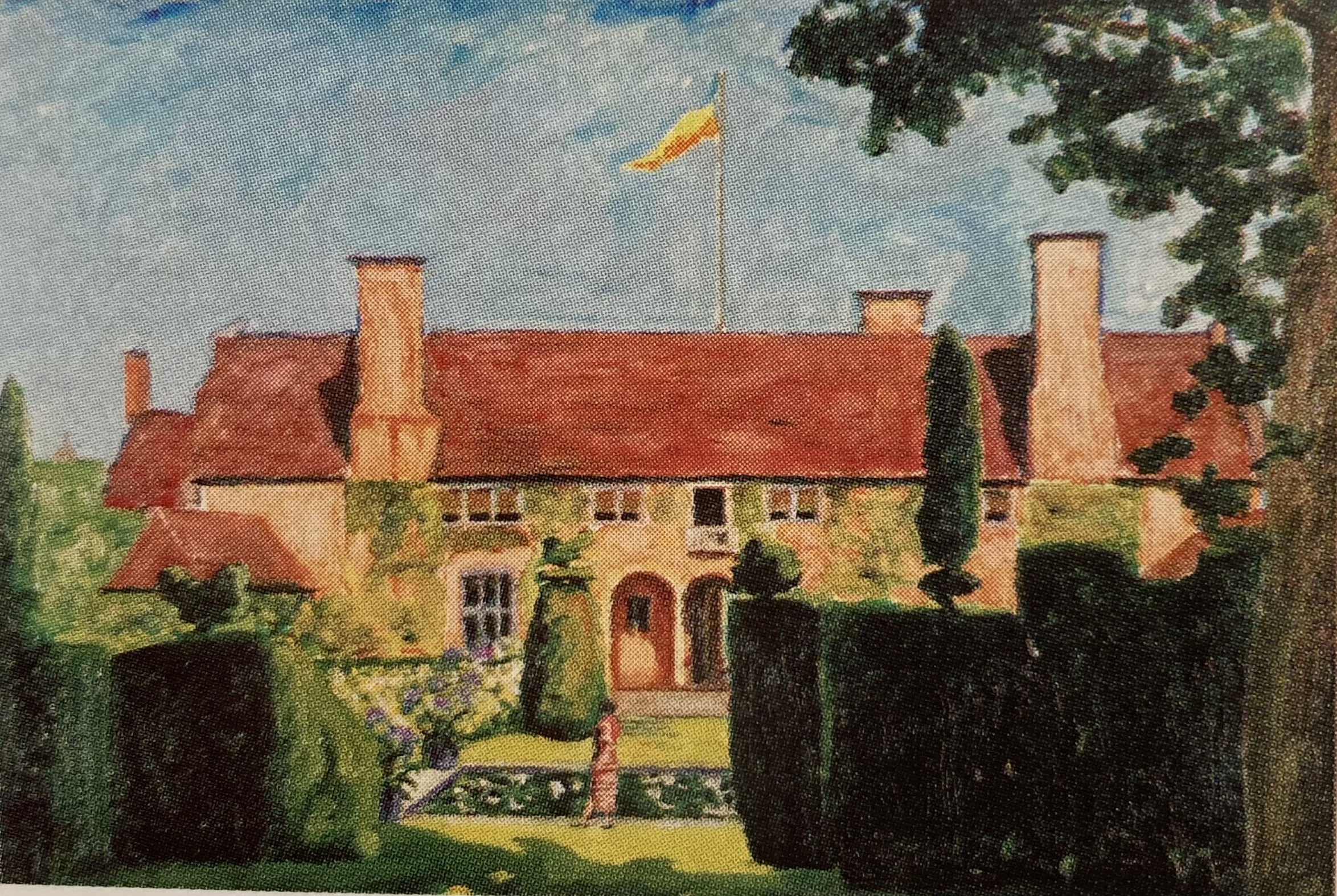
The house at Lympne.
|
Formal Gardens and Pavillion at Lympne. |
View over the Lympne marches. |

Top-Coast scene near Lympne, Below Left-Coast scene near Lympne, Below Right-View of the sea from a cliftop at Lympne.
Murray was also a painter, so for Clementine and Winston’s fiftieth anniversary he painted a picture of the Rialto Bridge and Grand Canal in Venice, one of the cities the Churchill’s had visited on their honeymoon in 1908. Churchill, so taken with the painting, he displayed it in his studio, the only canvas in the studio that was not one he had painted. Murray was given Churchill’s final painting. This final work can be viewed online at the International Churchill Society site. David Coombs has assigned this last painting C 544 in his catalogue of Churchill paintings.
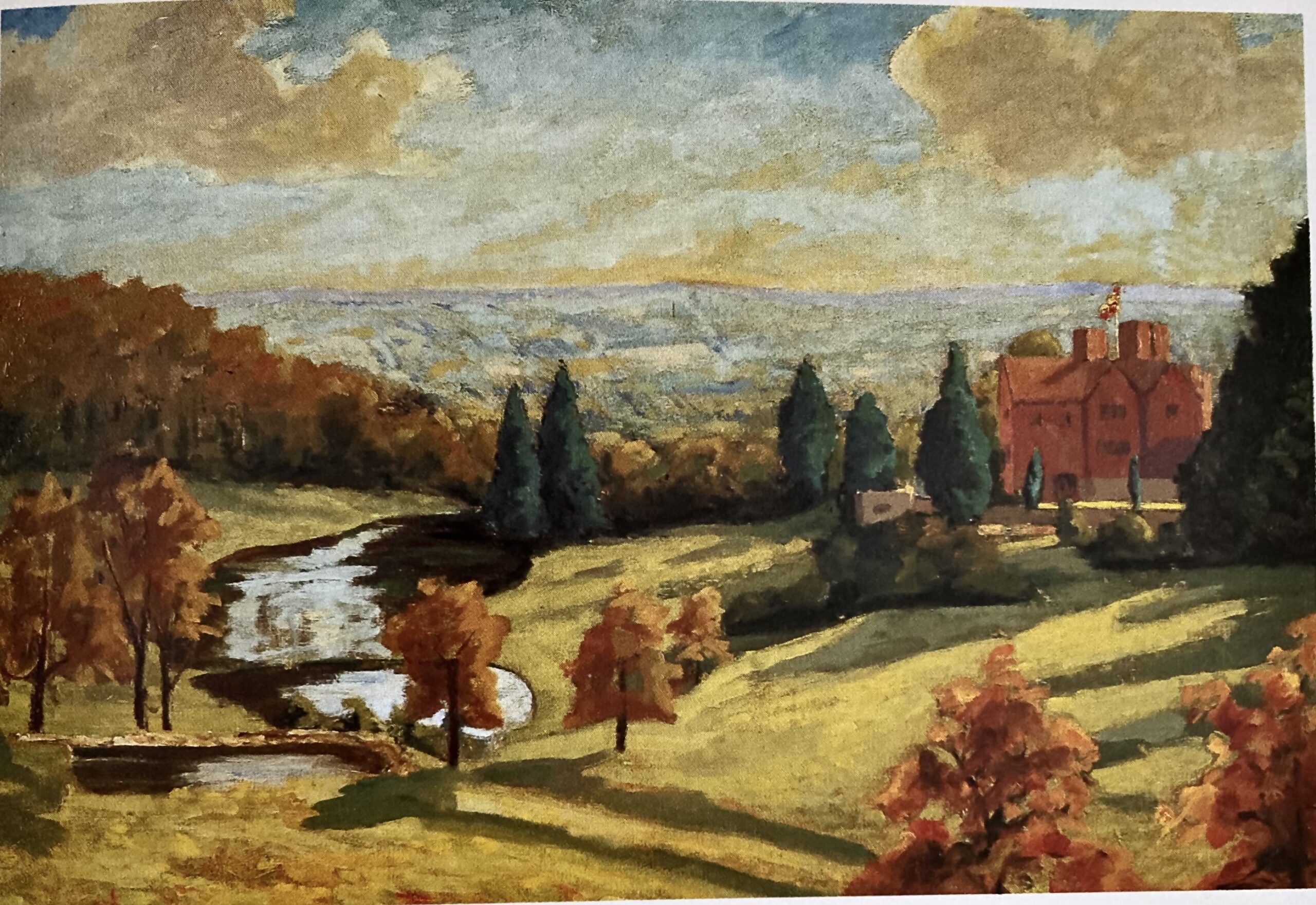
“View of Chartwell and its lakes showing the view on the background of the Kentish Weald that so attracted Churchill to purchase the house.”
|
“View from Chartwell showing Winston’s Studio in the centre foreground.” |
“The kitchen garden at Chartwell showing some of the walls built before the war by Churchill himself.” |
Churchill was half-American by birth. President John F. Kennedy granted him honorary citizenship in 1963. There are only eight people to have been given such an honor.
|
“Churchill wearing his Stetson on one of his final visits to the Côte d’Azur, 1963. |

“Sir Winston Churchill’s felt Stetson was given to Sgt. Murray.” |
Sir Winston Churchill died January 24, 1965. He was given a state funeral. The planning for this eventuality began in 1953, code-name “Operation Hope Not”, and completed by 1958. The funeral ceremony was held at St. Paul’s Cathedral on January 30. From there, his coffin was taken by boat along the River Thames to Waterloo Station. The coffin was put a special train to the family plot at St. Martin’s Church, Bladon, and buried beside his mother and brother Jack. St. Martin’s Church is near his birthplace at Blenheim Palace. He was 90 years of age.
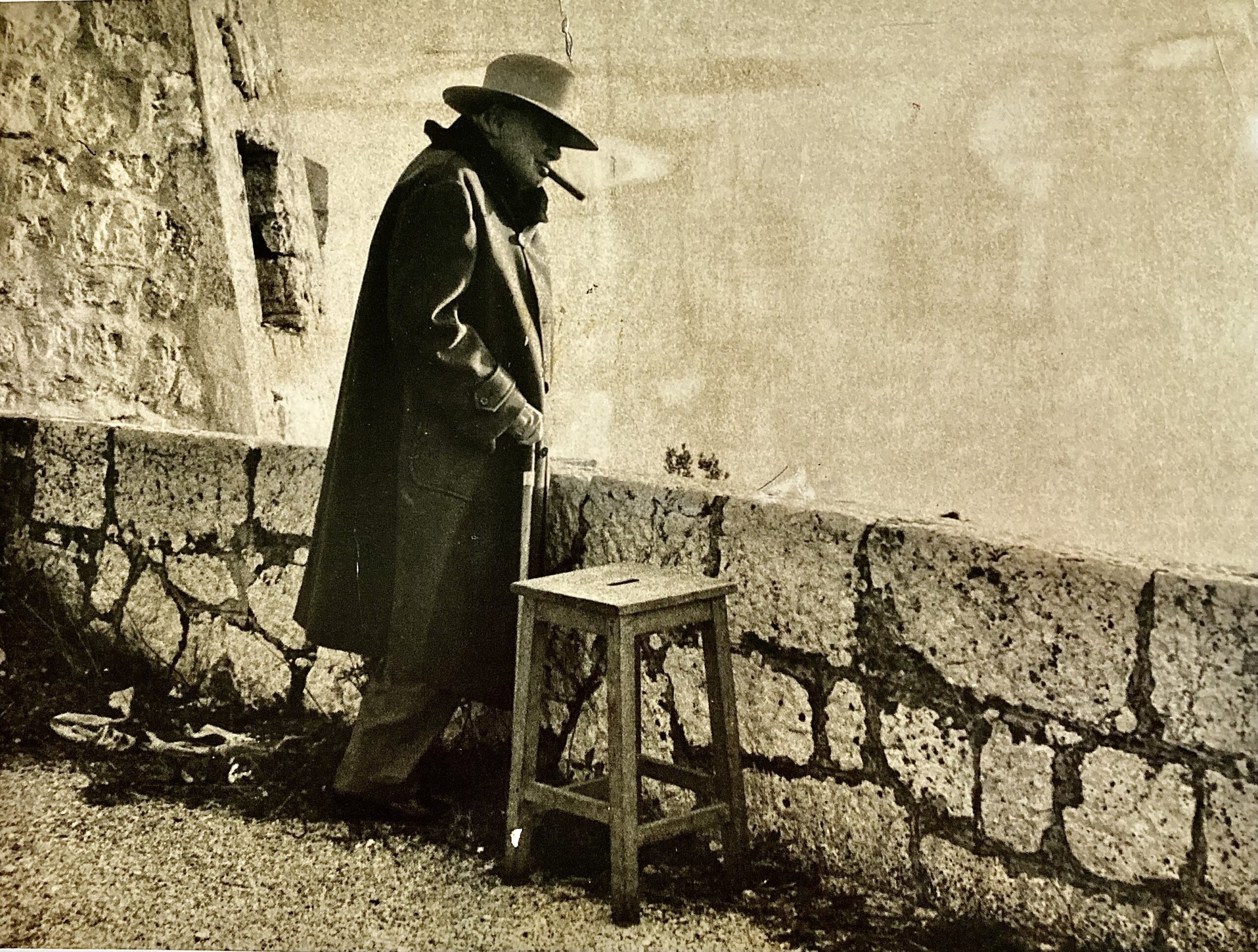
“Winston Churchill looking over Monte Carlo and the Mediterranean Sea from the Grande Corniche, December 1961.” A very favorite picture of mine.
|
La Montagne, Stainte Victoire. It was painted in 1948 based on two photographs in the Studio archives at Chartwell. xxxxxxxxxxxxxxxxxxxxxxxxxxxxxxxxxxxxxxxxxxxxxxxxxxxxxxxx xxxxxxxxxxxxxxxxxxxxxxxxxxx xxxxxxxxxxxxxxxxxxxxxxxxxxxx xxxxxxxxxxxxxxxxxxxxxx xxxxxxxxxxxxxxx xxxxxxxxxxxxxx xxxxxxxxxxxxxxxxxxxxx xxxxxxxxxxxxxxxxxxxxxxxx xxxxxxxxxxxxxxxxxx |

“The actual house (Rafferty photo of the house today) Churchill chose to paint in the foreground belonged to French artist André Masson…and still exists today.” He was a Cubist and Surrealist, fought for France and was seriously wounded, forced to flee first to Martinique and then on to New York, the Nazis objected to his paintings. He influenced Jackson Pollock. Cézanne painted Sainte Victoire one hundred times. |
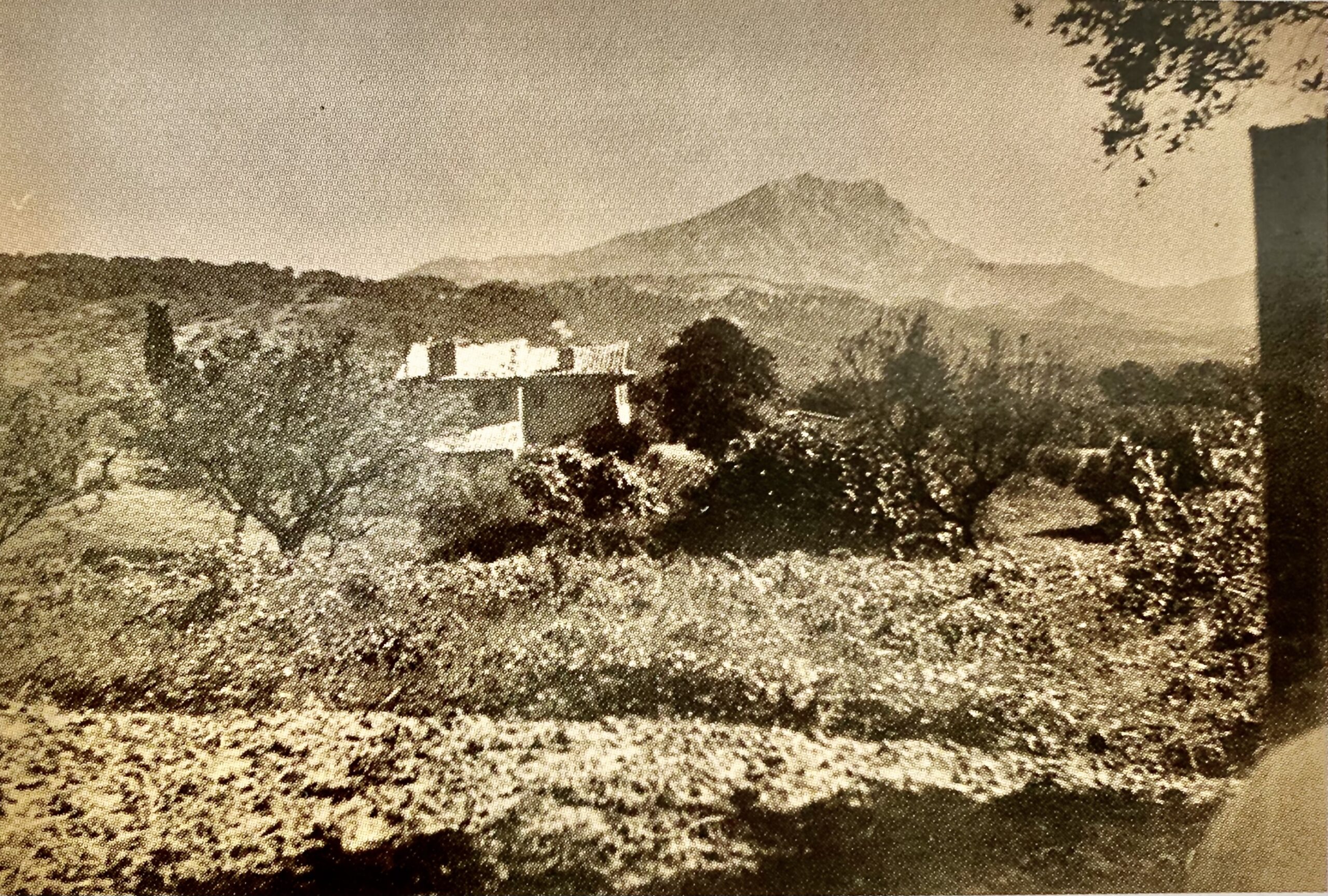
This photograph is from the Studio archives at Chartwell. With the help of Google Earth, Paul Rafferty was successful in finding the exact location. Rafferty points out in this photo that Churchill’s left shoulder is visible as is the edge of the canvas and just visible the edge of his Stetson hat.
In the forward to David Coombs with Minnie Churchill’s book, Mary Soames concludes thusly: “I hope many people will look at, read and enjoy this book – the vivid account of one man’s ‘joy-ride in a paint-box.’ ”
The final line of the Postscript, in the same book, sums up feelings I have had all along as I traveled through Winston Churchill’s “joy-ride in a paint-box.”. It reads as follows:
 |
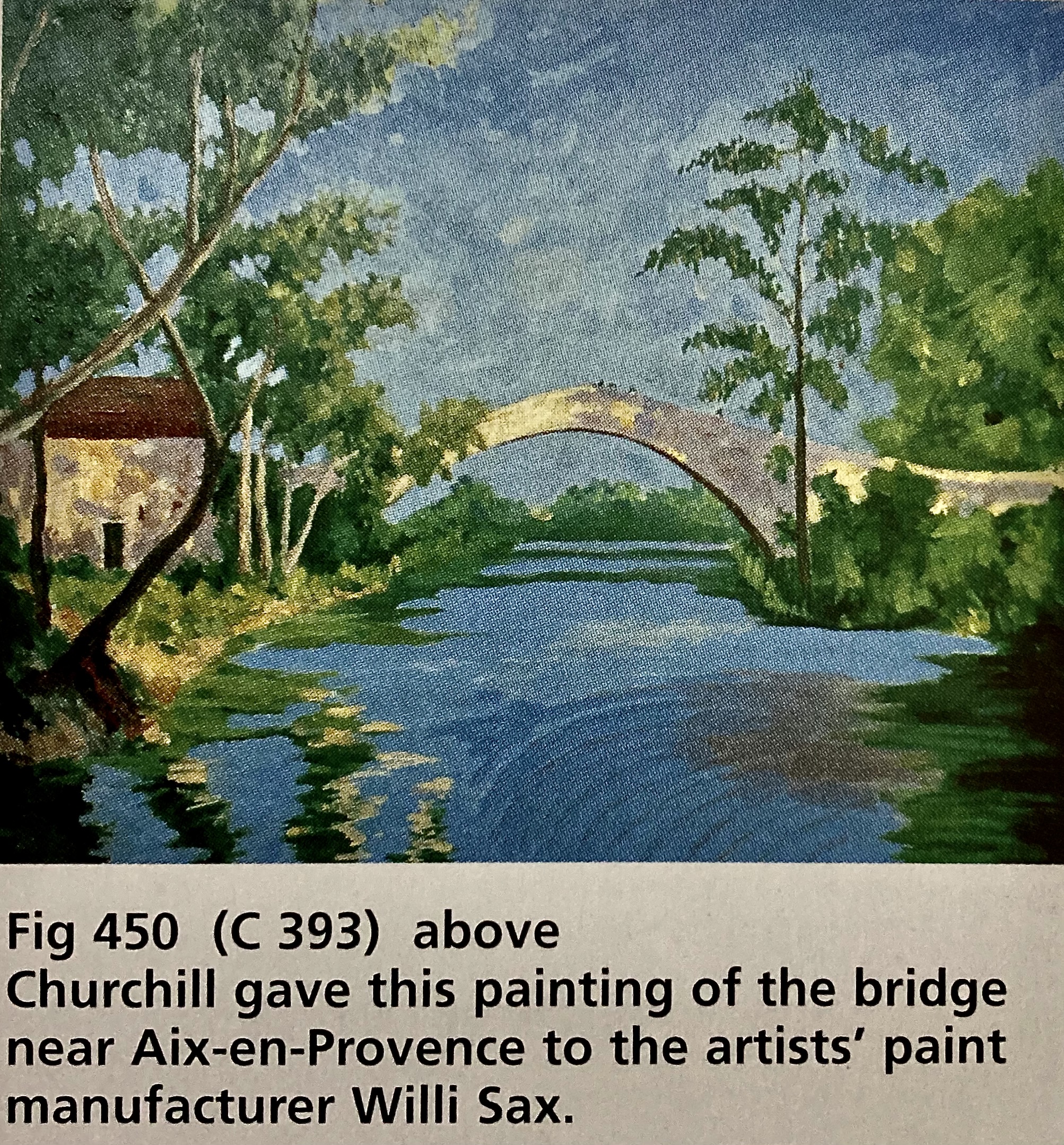 |
“The astonishing fact about Churchill the painter is that in spite of obstacles that would have prevented other men from painting at all, he painted a number of pictures of rare beauty.”
—Sir John Rothenstein
À bientôt
Quotes and Pictures:
Painting as a Pastime, by The Right Honourable Sir Winston Churchill, published in 1965 by Cornerstone Library, New York.
Winston Churchill-Painting on the French Riviera, by Paul Rafferty, published by Unicorn.
Sir Winston Churchill’s Life Through his Paintings, by David Coombs with Minnie Churchill, published by Gardners Books, 2003.
Churchill on the Riviera, by Nancy Smith, published by Biblio Publishing.
The Riviera Set, by Mary S. Lovell, published by Pegasus Books Ltd. 2018.
Churchill Defiant, by Barbara Leaming, published by Harper Perennial, 2010.





